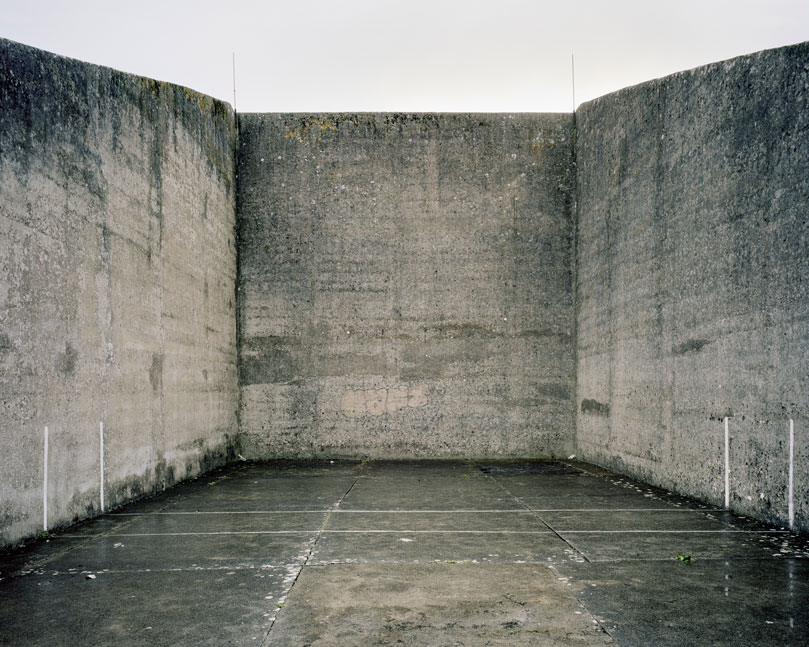
These are relics of a once vibrant chapter of Irish life. Like the dolmens John Montague crafted as a metaphor for the old people of his childhood, the ruins of these abandoned alleys bear silent testimony to a feature of Ireland that has perished through time and modernization. These plain walls were once the thriving open-air theatre's of their day. They were familiar meeting points, where people played games long into long summer evenings, and others gathered for simple companionship and discourse. The alleys came alive at a time in Ireland when human interaction needed little in the way of sophisticated props or accompaniments. In rural Ireland in particular handball captured the public imagination and societies grew around the games and the alleys which staged them. They became prized places of refuge, offering an escape from ordinary, hard-working lives.
At the ball alleys, some strategically placed at crossroads in the open countryside, generations happily fraternized. Some were drawn by the magic and noise of a game which has deep Irish roots. But the alley was more than a sporting venue; it became a vital anchor for the community and an invaluable leisure outlet. It also served as an unofficial meeting point for lovers and revolutionaries. Even as a location for executions. It had an open charter - multiple, indiscriminate possibilities. Like Montague's dolmens, some alleys survive - a portion of them intact and a minority enjoying new leases of life. But the majority are disappearing slowly from the landscape to the point where they will eventually become extinct. Many have been merged and camouflaged into other structures, like farmyard sheds or car parks, so that they are barely recognizable or identifiable. Many others are simply abandoned and overgrown. Old handball players and the game's scattered aficionados will recall their last hurrah 50 odd years ago or more, after they had thrived across the country for over a century, before television and better transport began to signal their decline and offer alternative means of entertainment and social collusion - leaving each one in turn to become a tomb for a lost civilization.
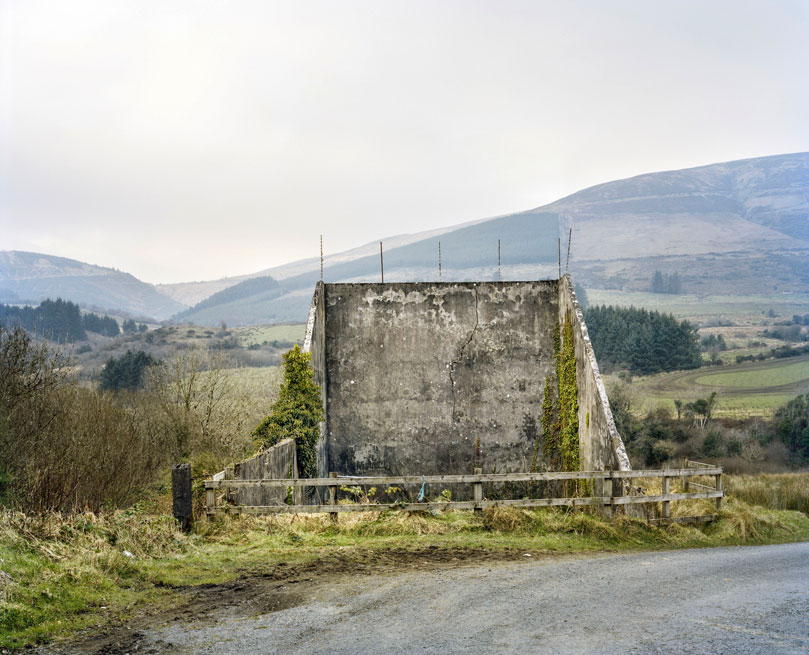
These are relics of a once vibrant chapter of Irish life. Like the dolmens John Montague crafted as a metaphor for the old people of his childhood, the ruins of these abandoned alleys bear silent testimony to a feature of Ireland that has perished through time and modernization. These plain walls were once the thriving open-air theatre's of their day. They were familiar meeting points, where people played games long into long summer evenings, and others gathered for simple companionship and discourse. The alleys came alive at a time in Ireland when human interaction needed little in the way of sophisticated props or accompaniments. In rural Ireland in particular handball captured the public imagination and societies grew around the games and the alleys which staged them. They became prized places of refuge, offering an escape from ordinary, hard-working lives.
At the ball alleys, some strategically placed at crossroads in the open countryside, generations happily fraternized. Some were drawn by the magic and noise of a game which has deep Irish roots. But the alley was more than a sporting venue; it became a vital anchor for the community and an invaluable leisure outlet. It also served as an unofficial meeting point for lovers and revolutionaries. Even as a location for executions. It had an open charter - multiple, indiscriminate possibilities. Like Montague's dolmens, some alleys survive - a portion of them intact and a minority enjoying new leases of life. But the majority are disappearing slowly from the landscape to the point where they will eventually become extinct. Many have been merged and camouflaged into other structures, like farmyard sheds or car parks, so that they are barely recognizable or identifiable. Many others are simply abandoned and overgrown. Old handball players and the game's scattered aficionados will recall their last hurrah 50 odd years ago or more, after they had thrived across the country for over a century, before television and better transport began to signal their decline and offer alternative means of entertainment and social collusion - leaving each one in turn to become a tomb for a lost civilization.

These are relics of a once vibrant chapter of Irish life. Like the dolmens John Montague crafted as a metaphor for the old people of his childhood, the ruins of these abandoned alleys bear silent testimony to a feature of Ireland that has perished through time and modernization. These plain walls were once the thriving open-air theatre's of their day. They were familiar meeting points, where people played games long into long summer evenings, and others gathered for simple companionship and discourse. The alleys came alive at a time in Ireland when human interaction needed little in the way of sophisticated props or accompaniments. In rural Ireland in particular handball captured the public imagination and societies grew around the games and the alleys which staged them. They became prized places of refuge, offering an escape from ordinary, hard-working lives.
At the ball alleys, some strategically placed at crossroads in the open countryside, generations happily fraternized. Some were drawn by the magic and noise of a game which has deep Irish roots. But the alley was more than a sporting venue; it became a vital anchor for the community and an invaluable leisure outlet. It also served as an unofficial meeting point for lovers and revolutionaries. Even as a location for executions. It had an open charter - multiple, indiscriminate possibilities. Like Montague's dolmens, some alleys survive - a portion of them intact and a minority enjoying new leases of life. But the majority are disappearing slowly from the landscape to the point where they will eventually become extinct. Many have been merged and camouflaged into other structures, like farmyard sheds or car parks, so that they are barely recognizable or identifiable. Many others are simply abandoned and overgrown. Old handball players and the game's scattered aficionados will recall their last hurrah 50 odd years ago or more, after they had thrived across the country for over a century, before television and better transport began to signal their decline and offer alternative means of entertainment and social collusion - leaving each one in turn to become a tomb for a lost civilization.
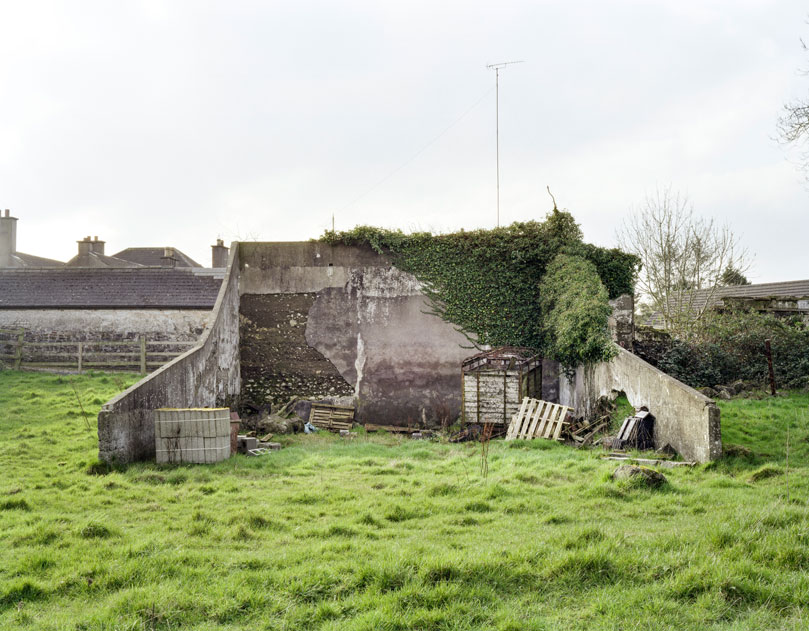
These are relics of a once vibrant chapter of Irish life. Like the dolmens John Montague crafted as a metaphor for the old people of his childhood, the ruins of these abandoned alleys bear silent testimony to a feature of Ireland that has perished through time and modernization. These plain walls were once the thriving open-air theatre's of their day. They were familiar meeting points, where people played games long into long summer evenings, and others gathered for simple companionship and discourse. The alleys came alive at a time in Ireland when human interaction needed little in the way of sophisticated props or accompaniments. In rural Ireland in particular handball captured the public imagination and societies grew around the games and the alleys which staged them. They became prized places of refuge, offering an escape from ordinary, hard-working lives.
At the ball alleys, some strategically placed at crossroads in the open countryside, generations happily fraternized. Some were drawn by the magic and noise of a game which has deep Irish roots. But the alley was more than a sporting venue; it became a vital anchor for the community and an invaluable leisure outlet. It also served as an unofficial meeting point for lovers and revolutionaries. Even as a location for executions. It had an open charter - multiple, indiscriminate possibilities. Like Montague's dolmens, some alleys survive - a portion of them intact and a minority enjoying new leases of life. But the majority are disappearing slowly from the landscape to the point where they will eventually become extinct. Many have been merged and camouflaged into other structures, like farmyard sheds or car parks, so that they are barely recognizable or identifiable. Many others are simply abandoned and overgrown. Old handball players and the game's scattered aficionados will recall their last hurrah 50 odd years ago or more, after they had thrived across the country for over a century, before television and better transport began to signal their decline and offer alternative means of entertainment and social collusion - leaving each one in turn to become a tomb for a lost civilization.

These are relics of a once vibrant chapter of Irish life. Like the dolmens John Montague crafted as a metaphor for the old people of his childhood, the ruins of these abandoned alleys bear silent testimony to a feature of Ireland that has perished through time and modernization. These plain walls were once the thriving open-air theatre's of their day. They were familiar meeting points, where people played games long into long summer evenings, and others gathered for simple companionship and discourse. The alleys came alive at a time in Ireland when human interaction needed little in the way of sophisticated props or accompaniments. In rural Ireland in particular handball captured the public imagination and societies grew around the games and the alleys which staged them. They became prized places of refuge, offering an escape from ordinary, hard-working lives.
At the ball alleys, some strategically placed at crossroads in the open countryside, generations happily fraternized. Some were drawn by the magic and noise of a game which has deep Irish roots. But the alley was more than a sporting venue; it became a vital anchor for the community and an invaluable leisure outlet. It also served as an unofficial meeting point for lovers and revolutionaries. Even as a location for executions. It had an open charter - multiple, indiscriminate possibilities. Like Montague's dolmens, some alleys survive - a portion of them intact and a minority enjoying new leases of life. But the majority are disappearing slowly from the landscape to the point where they will eventually become extinct. Many have been merged and camouflaged into other structures, like farmyard sheds or car parks, so that they are barely recognizable or identifiable. Many others are simply abandoned and overgrown. Old handball players and the game's scattered aficionados will recall their last hurrah 50 odd years ago or more, after they had thrived across the country for over a century, before television and better transport began to signal their decline and offer alternative means of entertainment and social collusion - leaving each one in turn to become a tomb for a lost civilization.
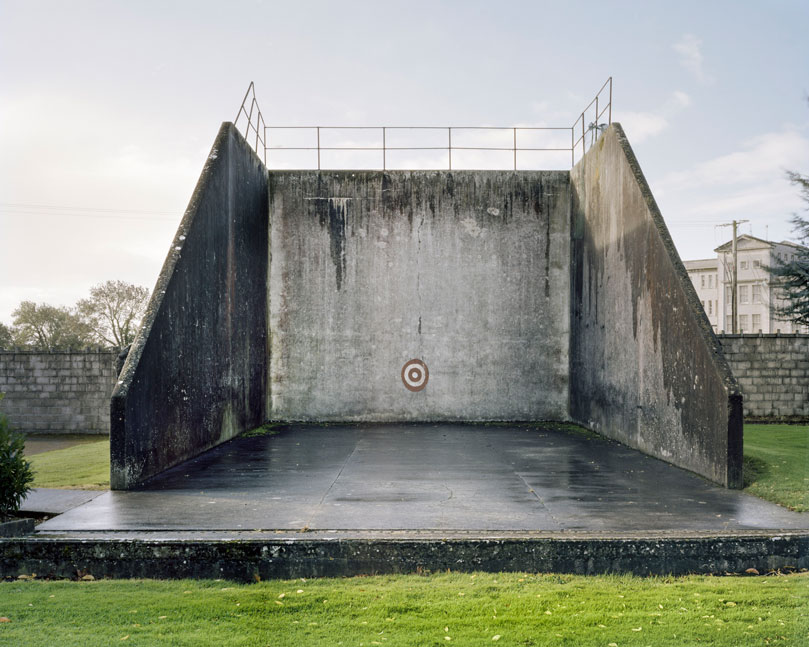
These are relics of a once vibrant chapter of Irish life. Like the dolmens John Montague crafted as a metaphor for the old people of his childhood, the ruins of these abandoned alleys bear silent testimony to a feature of Ireland that has perished through time and modernization. These plain walls were once the thriving open-air theatre's of their day. They were familiar meeting points, where people played games long into long summer evenings, and others gathered for simple companionship and discourse. The alleys came alive at a time in Ireland when human interaction needed little in the way of sophisticated props or accompaniments. In rural Ireland in particular handball captured the public imagination and societies grew around the games and the alleys which staged them. They became prized places of refuge, offering an escape from ordinary, hard-working lives.
At the ball alleys, some strategically placed at crossroads in the open countryside, generations happily fraternized. Some were drawn by the magic and noise of a game which has deep Irish roots. But the alley was more than a sporting venue; it became a vital anchor for the community and an invaluable leisure outlet. It also served as an unofficial meeting point for lovers and revolutionaries. Even as a location for executions. It had an open charter - multiple, indiscriminate possibilities. Like Montague's dolmens, some alleys survive - a portion of them intact and a minority enjoying new leases of life. But the majority are disappearing slowly from the landscape to the point where they will eventually become extinct. Many have been merged and camouflaged into other structures, like farmyard sheds or car parks, so that they are barely recognizable or identifiable. Many others are simply abandoned and overgrown. Old handball players and the game's scattered aficionados will recall their last hurrah 50 odd years ago or more, after they had thrived across the country for over a century, before television and better transport began to signal their decline and offer alternative means of entertainment and social collusion - leaving each one in turn to become a tomb for a lost civilization.
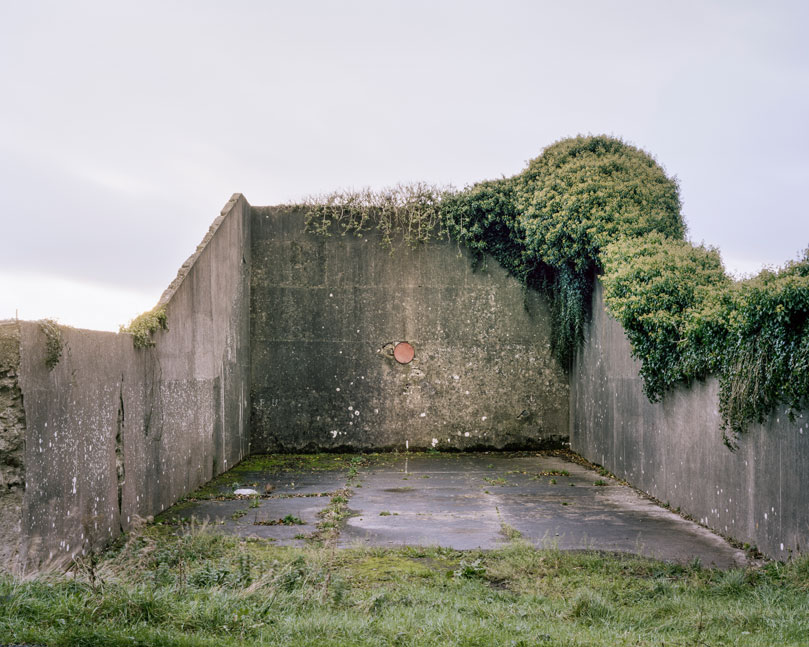
These are relics of a once vibrant chapter of Irish life. Like the dolmens John Montague crafted as a metaphor for the old people of his childhood, the ruins of these abandoned alleys bear silent testimony to a feature of Ireland that has perished through time and modernization. These plain walls were once the thriving open-air theatre's of their day. They were familiar meeting points, where people played games long into long summer evenings, and others gathered for simple companionship and discourse. The alleys came alive at a time in Ireland when human interaction needed little in the way of sophisticated props or accompaniments. In rural Ireland in particular handball captured the public imagination and societies grew around the games and the alleys which staged them. They became prized places of refuge, offering an escape from ordinary, hard-working lives.
At the ball alleys, some strategically placed at crossroads in the open countryside, generations happily fraternized. Some were drawn by the magic and noise of a game which has deep Irish roots. But the alley was more than a sporting venue; it became a vital anchor for the community and an invaluable leisure outlet. It also served as an unofficial meeting point for lovers and revolutionaries. Even as a location for executions. It had an open charter - multiple, indiscriminate possibilities. Like Montague's dolmens, some alleys survive - a portion of them intact and a minority enjoying new leases of life. But the majority are disappearing slowly from the landscape to the point where they will eventually become extinct. Many have been merged and camouflaged into other structures, like farmyard sheds or car parks, so that they are barely recognizable or identifiable. Many others are simply abandoned and overgrown. Old handball players and the game's scattered aficionados will recall their last hurrah 50 odd years ago or more, after they had thrived across the country for over a century, before television and better transport began to signal their decline and offer alternative means of entertainment and social collusion - leaving each one in turn to become a tomb for a lost civilization.

These are relics of a once vibrant chapter of Irish life. Like the dolmens John Montague crafted as a metaphor for the old people of his childhood, the ruins of these abandoned alleys bear silent testimony to a feature of Ireland that has perished through time and modernization. These plain walls were once the thriving open-air theatre's of their day. They were familiar meeting points, where people played games long into long summer evenings, and others gathered for simple companionship and discourse. The alleys came alive at a time in Ireland when human interaction needed little in the way of sophisticated props or accompaniments. In rural Ireland in particular handball captured the public imagination and societies grew around the games and the alleys which staged them. They became prized places of refuge, offering an escape from ordinary, hard-working lives.
At the ball alleys, some strategically placed at crossroads in the open countryside, generations happily fraternized. Some were drawn by the magic and noise of a game which has deep Irish roots. But the alley was more than a sporting venue; it became a vital anchor for the community and an invaluable leisure outlet. It also served as an unofficial meeting point for lovers and revolutionaries. Even as a location for executions. It had an open charter - multiple, indiscriminate possibilities. Like Montague's dolmens, some alleys survive - a portion of them intact and a minority enjoying new leases of life. But the majority are disappearing slowly from the landscape to the point where they will eventually become extinct. Many have been merged and camouflaged into other structures, like farmyard sheds or car parks, so that they are barely recognizable or identifiable. Many others are simply abandoned and overgrown. Old handball players and the game's scattered aficionados will recall their last hurrah 50 odd years ago or more, after they had thrived across the country for over a century, before television and better transport began to signal their decline and offer alternative means of entertainment and social collusion - leaving each one in turn to become a tomb for a lost civilization.

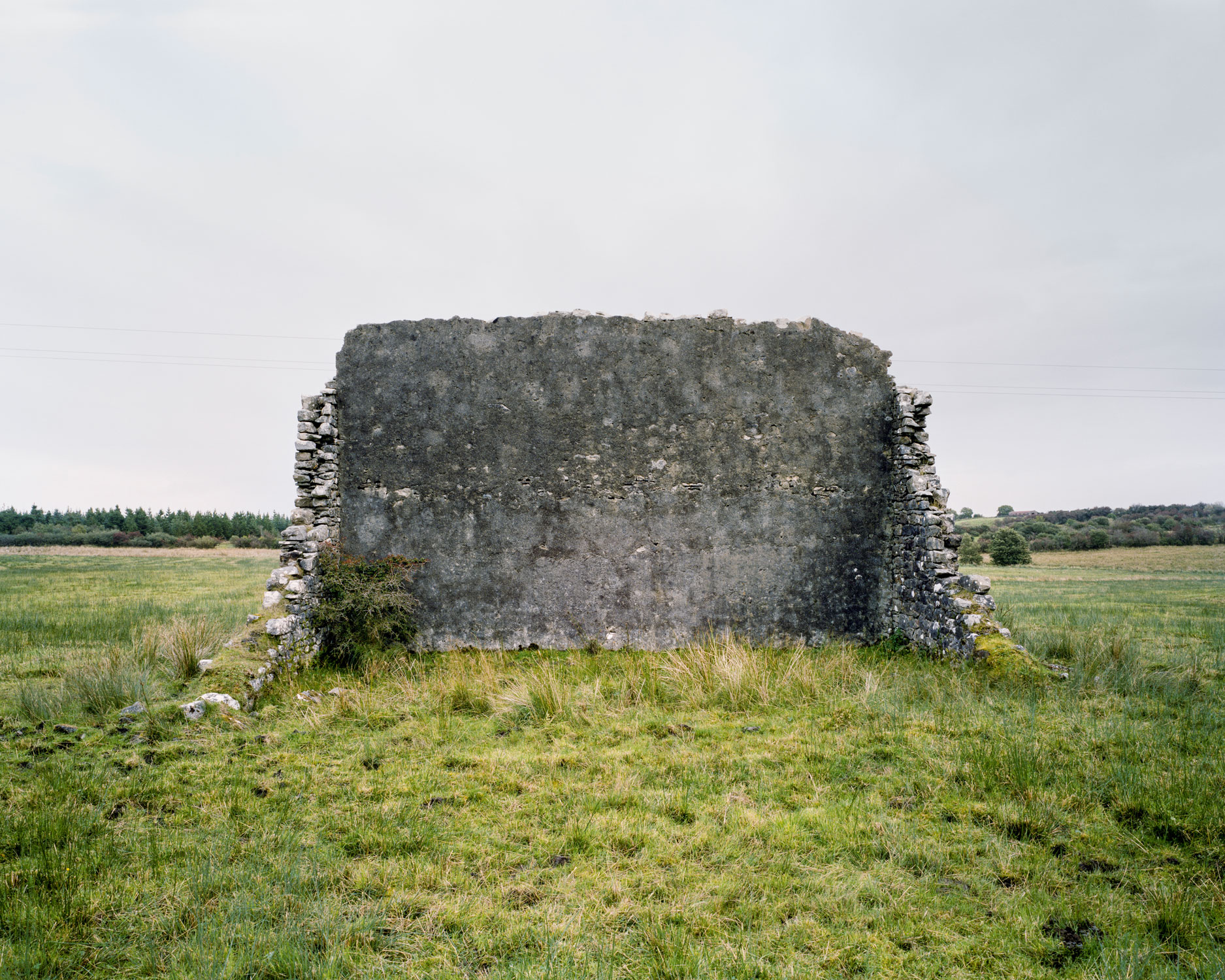
These are relics of a once vibrant chapter of Irish life. Like the dolmens John Montague crafted as a metaphor for the old people of his childhood, the ruins of these abandoned alleys bear silent testimony to a feature of Ireland that has perished through time and modernization. These plain walls were once the thriving open-air theatre's of their day. They were familiar meeting points, where people played games long into long summer evenings, and others gathered for simple companionship and discourse. The alleys came alive at a time in Ireland when human interaction needed little in the way of sophisticated props or accompaniments. In rural Ireland in particular handball captured the public imagination and societies grew around the games and the alleys which staged them. They became prized places of refuge, offering an escape from ordinary, hard-working lives.
At the ball alleys, some strategically placed at crossroads in the open countryside, generations happily fraternized. Some were drawn by the magic and noise of a game which has deep Irish roots. But the alley was more than a sporting venue; it became a vital anchor for the community and an invaluable leisure outlet. It also served as an unofficial meeting point for lovers and revolutionaries. Even as a location for executions. It had an open charter - multiple, indiscriminate possibilities. Like Montague's dolmens, some alleys survive - a portion of them intact and a minority enjoying new leases of life. But the majority are disappearing slowly from the landscape to the point where they will eventually become extinct. Many have been merged and camouflaged into other structures, like farmyard sheds or car parks, so that they are barely recognizable or identifiable. Many others are simply abandoned and overgrown. Old handball players and the game's scattered aficionados will recall their last hurrah 50 odd years ago or more, after they had thrived across the country for over a century, before television and better transport began to signal their decline and offer alternative means of entertainment and social collusion - leaving each one in turn to become a tomb for a lost civilization.
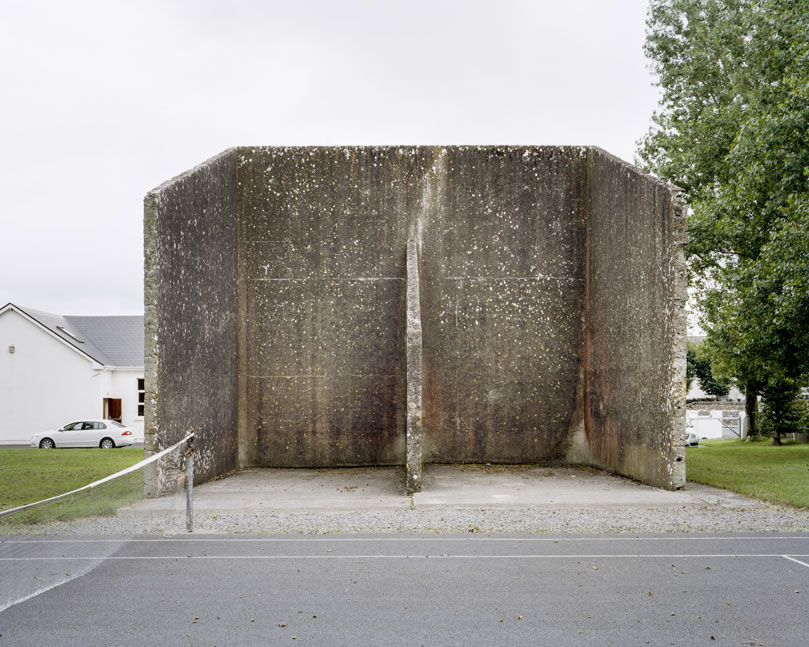
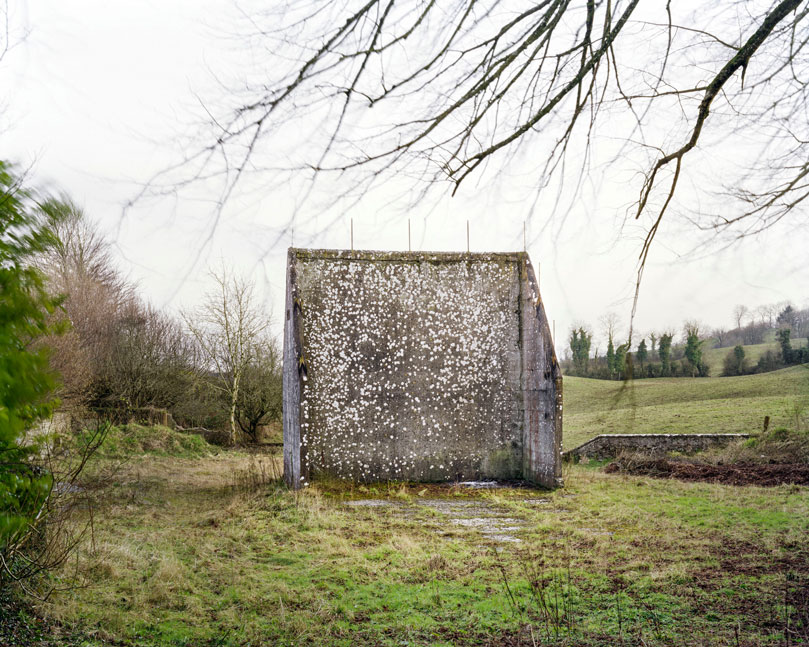
These are relics of a once vibrant chapter of Irish life. Like the dolmens John Montague crafted as a metaphor for the old people of his childhood, the ruins of these abandoned alleys bear silent testimony to a feature of Ireland that has perished through time and modernization. These plain walls were once the thriving open-air theatre's of their day. They were familiar meeting points, where people played games long into long summer evenings, and others gathered for simple companionship and discourse. The alleys came alive at a time in Ireland when human interaction needed little in the way of sophisticated props or accompaniments. In rural Ireland in particular handball captured the public imagination and societies grew around the games and the alleys which staged them. They became prized places of refuge, offering an escape from ordinary, hard-working lives.
At the ball alleys, some strategically placed at crossroads in the open countryside, generations happily fraternized. Some were drawn by the magic and noise of a game which has deep Irish roots. But the alley was more than a sporting venue; it became a vital anchor for the community and an invaluable leisure outlet. It also served as an unofficial meeting point for lovers and revolutionaries. Even as a location for executions. It had an open charter - multiple, indiscriminate possibilities. Like Montague's dolmens, some alleys survive - a portion of them intact and a minority enjoying new leases of life. But the majority are disappearing slowly from the landscape to the point where they will eventually become extinct. Many have been merged and camouflaged into other structures, like farmyard sheds or car parks, so that they are barely recognizable or identifiable. Many others are simply abandoned and overgrown. Old handball players and the game's scattered aficionados will recall their last hurrah 50 odd years ago or more, after they had thrived across the country for over a century, before television and better transport began to signal their decline and offer alternative means of entertainment and social collusion - leaving each one in turn to become a tomb for a lost civilization.
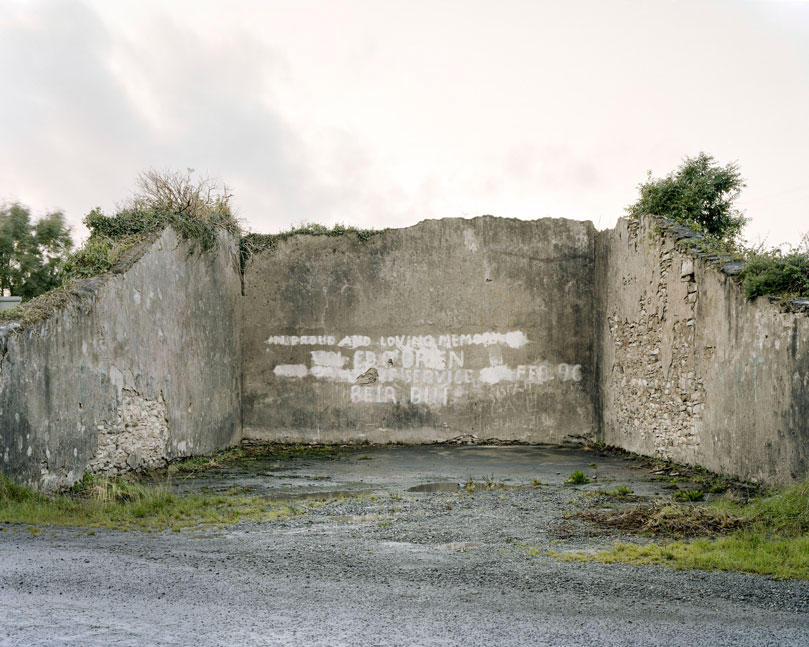
These are relics of a once vibrant chapter of Irish life. Like the dolmens John Montague crafted as a metaphor for the old people of his childhood, the ruins of these abandoned alleys bear silent testimony to a feature of Ireland that has perished through time and modernization. These plain walls were once the thriving open-air theatre's of their day. They were familiar meeting points, where people played games long into long summer evenings, and others gathered for simple companionship and discourse. The alleys came alive at a time in Ireland when human interaction needed little in the way of sophisticated props or accompaniments. In rural Ireland in particular handball captured the public imagination and societies grew around the games and the alleys which staged them. They became prized places of refuge, offering an escape from ordinary, hard-working lives.
At the ball alleys, some strategically placed at crossroads in the open countryside, generations happily fraternized. Some were drawn by the magic and noise of a game which has deep Irish roots. But the alley was more than a sporting venue; it became a vital anchor for the community and an invaluable leisure outlet. It also served as an unofficial meeting point for lovers and revolutionaries. Even as a location for executions. It had an open charter - multiple, indiscriminate possibilities. Like Montague's dolmens, some alleys survive - a portion of them intact and a minority enjoying new leases of life. But the majority are disappearing slowly from the landscape to the point where they will eventually become extinct. Many have been merged and camouflaged into other structures, like farmyard sheds or car parks, so that they are barely recognizable or identifiable. Many others are simply abandoned and overgrown. Old handball players and the game's scattered aficionados will recall their last hurrah 50 odd years ago or more, after they had thrived across the country for over a century, before television and better transport began to signal their decline and offer alternative means of entertainment and social collusion - leaving each one in turn to become a tomb for a lost civilization.
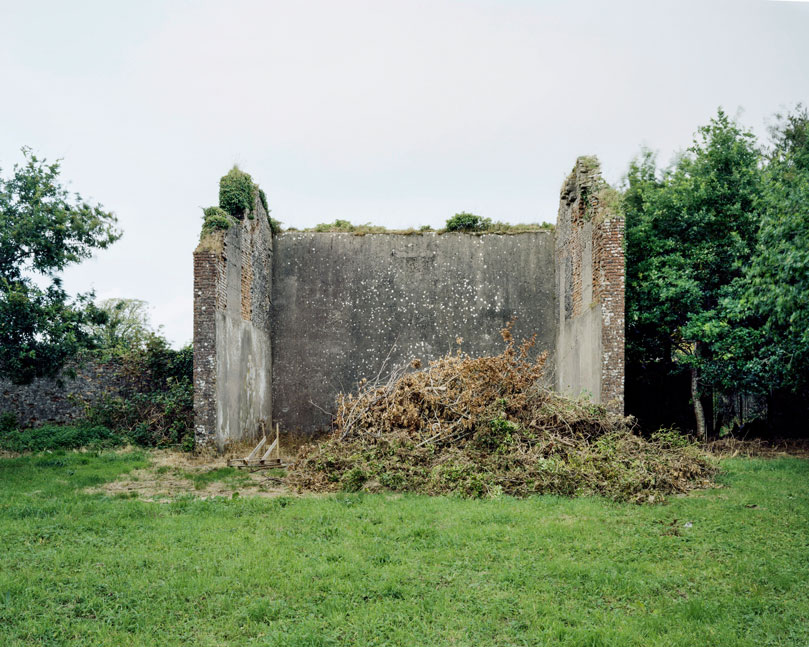
These are relics of a once vibrant chapter of Irish life. Like the dolmens John Montague crafted as a metaphor for the old people of his childhood, the ruins of these abandoned alleys bear silent testimony to a feature of Ireland that has perished through time and modernization. These plain walls were once the thriving open-air theatre's of their day. They were familiar meeting points, where people played games long into long summer evenings, and others gathered for simple companionship and discourse. The alleys came alive at a time in Ireland when human interaction needed little in the way of sophisticated props or accompaniments. In rural Ireland in particular handball captured the public imagination and societies grew around the games and the alleys which staged them. They became prized places of refuge, offering an escape from ordinary, hard-working lives.
At the ball alleys, some strategically placed at crossroads in the open countryside, generations happily fraternized. Some were drawn by the magic and noise of a game which has deep Irish roots. But the alley was more than a sporting venue; it became a vital anchor for the community and an invaluable leisure outlet. It also served as an unofficial meeting point for lovers and revolutionaries. Even as a location for executions. It had an open charter - multiple, indiscriminate possibilities. Like Montague's dolmens, some alleys survive - a portion of them intact and a minority enjoying new leases of life. But the majority are disappearing slowly from the landscape to the point where they will eventually become extinct. Many have been merged and camouflaged into other structures, like farmyard sheds or car parks, so that they are barely recognizable or identifiable. Many others are simply abandoned and overgrown. Old handball players and the game's scattered aficionados will recall their last hurrah 50 odd years ago or more, after they had thrived across the country for over a century, before television and better transport began to signal their decline and offer alternative means of entertainment and social collusion - leaving each one in turn to become a tomb for a lost civilization.
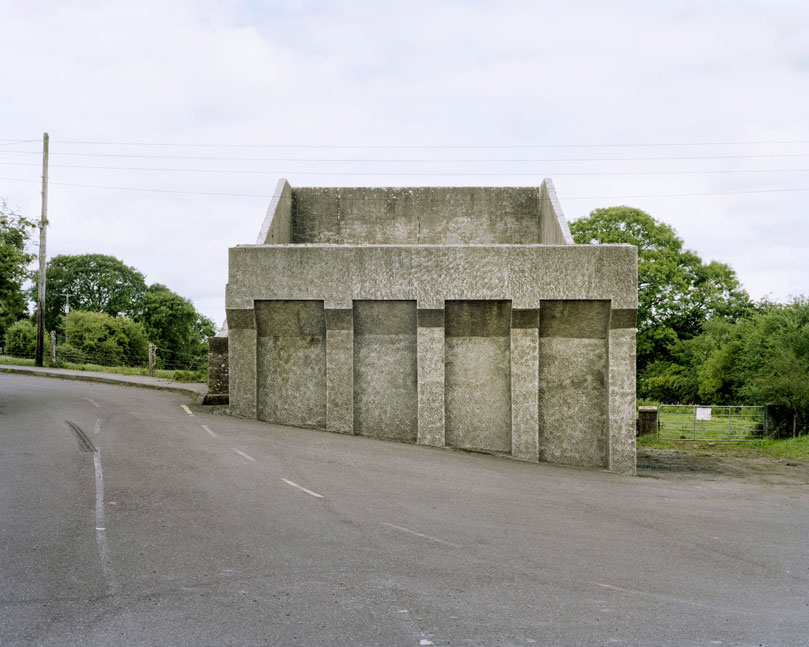
These are relics of a once vibrant chapter of Irish life. Like the dolmens John Montague crafted as a metaphor for the old people of his childhood, the ruins of these abandoned alleys bear silent testimony to a feature of Ireland that has perished through time and modernization. These plain walls were once the thriving open-air theatre's of their day. They were familiar meeting points, where people played games long into long summer evenings, and others gathered for simple companionship and discourse. The alleys came alive at a time in Ireland when human interaction needed little in the way of sophisticated props or accompaniments. In rural Ireland in particular handball captured the public imagination and societies grew around the games and the alleys which staged them. They became prized places of refuge, offering an escape from ordinary, hard-working lives.
At the ball alleys, some strategically placed at crossroads in the open countryside, generations happily fraternized. Some were drawn by the magic and noise of a game which has deep Irish roots. But the alley was more than a sporting venue; it became a vital anchor for the community and an invaluable leisure outlet. It also served as an unofficial meeting point for lovers and revolutionaries. Even as a location for executions. It had an open charter - multiple, indiscriminate possibilities. Like Montague's dolmens, some alleys survive - a portion of them intact and a minority enjoying new leases of life. But the majority are disappearing slowly from the landscape to the point where they will eventually become extinct. Many have been merged and camouflaged into other structures, like farmyard sheds or car parks, so that they are barely recognizable or identifiable. Many others are simply abandoned and overgrown. Old handball players and the game's scattered aficionados will recall their last hurrah 50 odd years ago or more, after they had thrived across the country for over a century, before television and better transport began to signal their decline and offer alternative means of entertainment and social collusion - leaving each one in turn to become a tomb for a lost civilization.

These are relics of a once vibrant chapter of Irish life. Like the dolmens John Montague crafted as a metaphor for the old people of his childhood, the ruins of these abandoned alleys bear silent testimony to a feature of Ireland that has perished through time and modernization. These plain walls were once the thriving open-air theatre's of their day. They were familiar meeting points, where people played games long into long summer evenings, and others gathered for simple companionship and discourse. The alleys came alive at a time in Ireland when human interaction needed little in the way of sophisticated props or accompaniments. In rural Ireland in particular handball captured the public imagination and societies grew around the games and the alleys which staged them. They became prized places of refuge, offering an escape from ordinary, hard-working lives.
At the ball alleys, some strategically placed at crossroads in the open countryside, generations happily fraternized. Some were drawn by the magic and noise of a game which has deep Irish roots. But the alley was more than a sporting venue; it became a vital anchor for the community and an invaluable leisure outlet. It also served as an unofficial meeting point for lovers and revolutionaries. Even as a location for executions. It had an open charter - multiple, indiscriminate possibilities. Like Montague's dolmens, some alleys survive - a portion of them intact and a minority enjoying new leases of life. But the majority are disappearing slowly from the landscape to the point where they will eventually become extinct. Many have been merged and camouflaged into other structures, like farmyard sheds or car parks, so that they are barely recognizable or identifiable. Many others are simply abandoned and overgrown. Old handball players and the game's scattered aficionados will recall their last hurrah 50 odd years ago or more, after they had thrived across the country for over a century, before television and better transport began to signal their decline and offer alternative means of entertainment and social collusion - leaving each one in turn to become a tomb for a lost civilization.
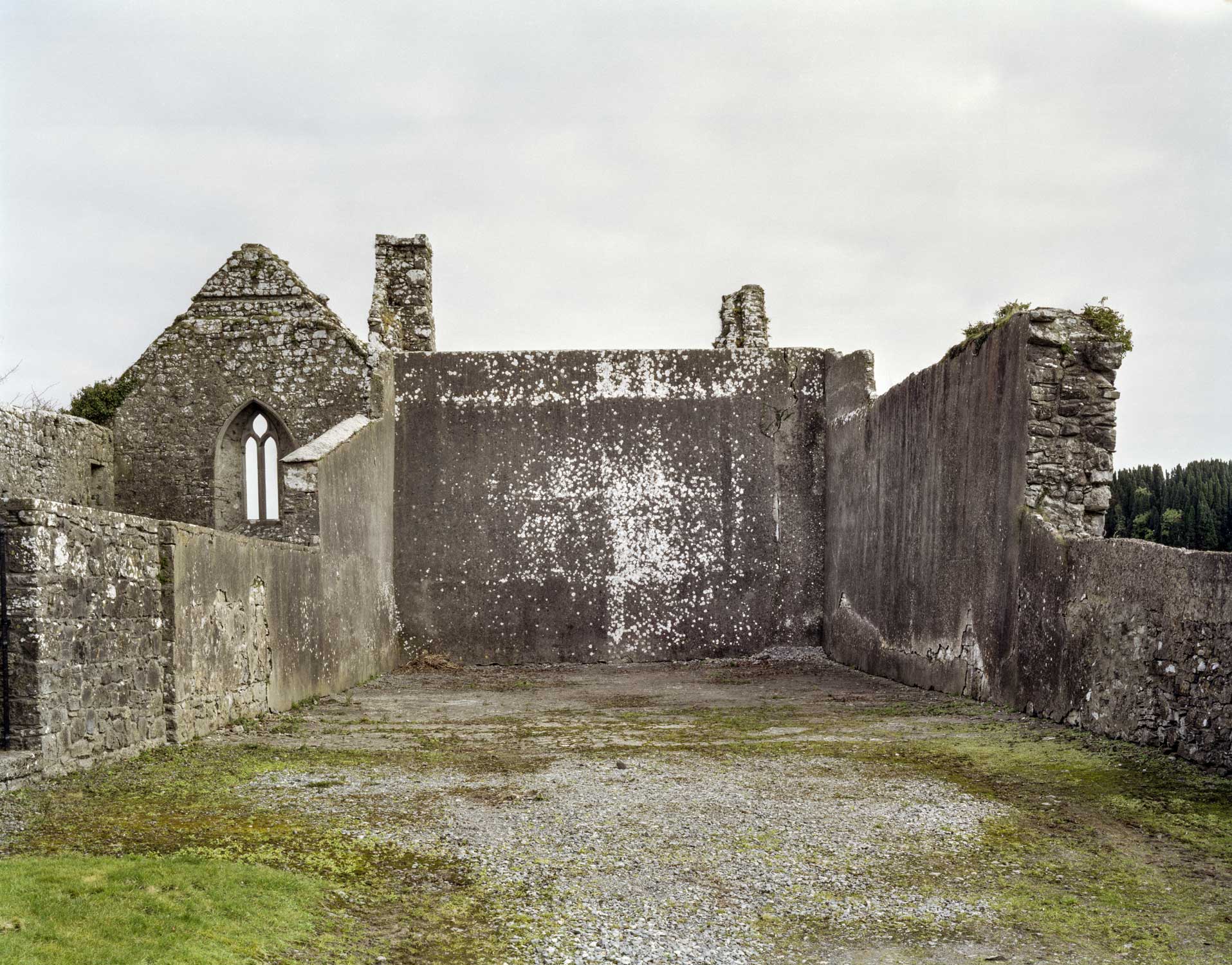
These are relics of a once vibrant chapter of Irish life. Like the dolmens John Montague crafted as a metaphor for the old people of his childhood, the ruins of these abandoned alleys bear silent testimony to a feature of Ireland that has perished through time and modernization. These plain walls were once the thriving open-air theatre's of their day. They were familiar meeting points, where people played games long into long summer evenings, and others gathered for simple companionship and discourse. The alleys came alive at a time in Ireland when human interaction needed little in the way of sophisticated props or accompaniments. In rural Ireland in particular handball captured the public imagination and societies grew around the games and the alleys which staged them. They became prized places of refuge, offering an escape from ordinary, hard-working lives.
At the ball alleys, some strategically placed at crossroads in the open countryside, generations happily fraternized. Some were drawn by the magic and noise of a game which has deep Irish roots. But the alley was more than a sporting venue; it became a vital anchor for the community and an invaluable leisure outlet. It also served as an unofficial meeting point for lovers and revolutionaries. Even as a location for executions. It had an open charter - multiple, indiscriminate possibilities. Like Montague's dolmens, some alleys survive - a portion of them intact and a minority enjoying new leases of life. But the majority are disappearing slowly from the landscape to the point where they will eventually become extinct. Many have been merged and camouflaged into other structures, like farmyard sheds or car parks, so that they are barely recognizable or identifiable. Many others are simply abandoned and overgrown. Old handball players and the game's scattered aficionados will recall their last hurrah 50 odd years ago or more, after they had thrived across the country for over a century, before television and better transport began to signal their decline and offer alternative means of entertainment and social collusion - leaving each one in turn to become a tomb for a lost civilization.
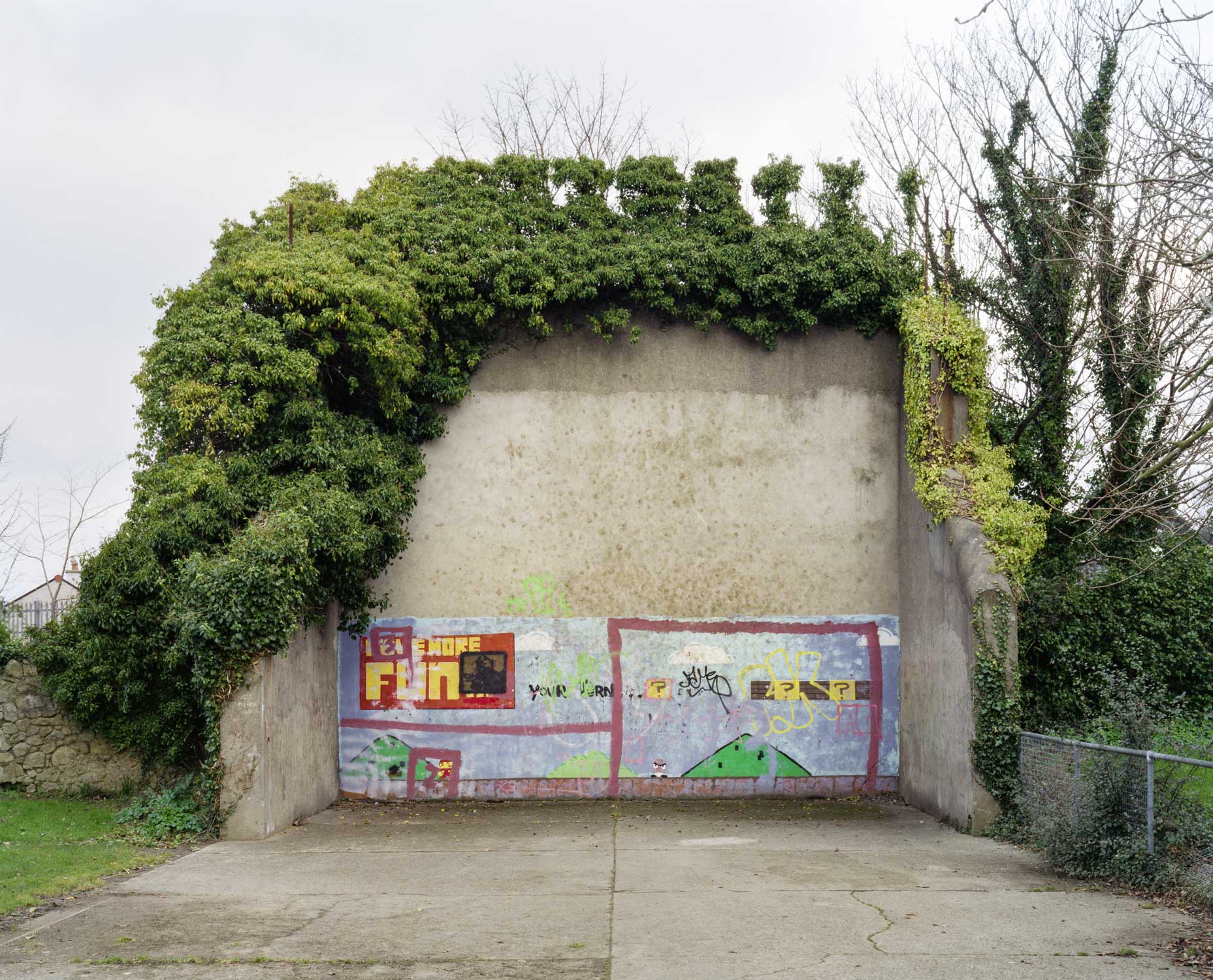
These are relics of a once vibrant chapter of Irish life. Like the dolmens John Montague crafted as a metaphor for the old people of his childhood, the ruins of these abandoned alleys bear silent testimony to a feature of Ireland that has perished through time and modernization. These plain walls were once the thriving open-air theatre's of their day. They were familiar meeting points, where people played games long into long summer evenings, and others gathered for simple companionship and discourse. The alleys came alive at a time in Ireland when human interaction needed little in the way of sophisticated props or accompaniments. In rural Ireland in particular handball captured the public imagination and societies grew around the games and the alleys which staged them. They became prized places of refuge, offering an escape from ordinary, hard-working lives.
At the ball alleys, some strategically placed at crossroads in the open countryside, generations happily fraternized. Some were drawn by the magic and noise of a game which has deep Irish roots. But the alley was more than a sporting venue; it became a vital anchor for the community and an invaluable leisure outlet. It also served as an unofficial meeting point for lovers and revolutionaries. Even as a location for executions. It had an open charter - multiple, indiscriminate possibilities. Like Montague's dolmens, some alleys survive - a portion of them intact and a minority enjoying new leases of life. But the majority are disappearing slowly from the landscape to the point where they will eventually become extinct. Many have been merged and camouflaged into other structures, like farmyard sheds or car parks, so that they are barely recognizable or identifiable. Many others are simply abandoned and overgrown. Old handball players and the game's scattered aficionados will recall their last hurrah 50 odd years ago or more, after they had thrived across the country for over a century, before television and better transport began to signal their decline and offer alternative means of entertainment and social collusion - leaving each one in turn to become a tomb for a lost civilization.
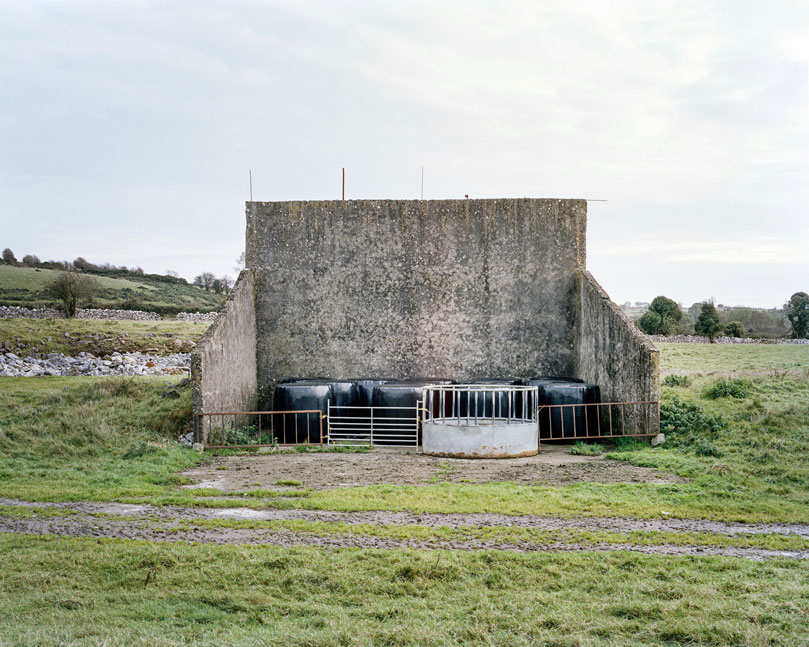
These are relics of a once vibrant chapter of Irish life. Like the dolmens John Montague crafted as a metaphor for the old people of his childhood, the ruins of these abandoned alleys bear silent testimony to a feature of Ireland that has perished through time and modernization. These plain walls were once the thriving open-air theatre's of their day. They were familiar meeting points, where people played games long into long summer evenings, and others gathered for simple companionship and discourse. The alleys came alive at a time in Ireland when human interaction needed little in the way of sophisticated props or accompaniments. In rural Ireland in particular handball captured the public imagination and societies grew around the games and the alleys which staged them. They became prized places of refuge, offering an escape from ordinary, hard-working lives.
At the ball alleys, some strategically placed at crossroads in the open countryside, generations happily fraternized. Some were drawn by the magic and noise of a game which has deep Irish roots. But the alley was more than a sporting venue; it became a vital anchor for the community and an invaluable leisure outlet. It also served as an unofficial meeting point for lovers and revolutionaries. Even as a location for executions. It had an open charter - multiple, indiscriminate possibilities. Like Montague's dolmens, some alleys survive - a portion of them intact and a minority enjoying new leases of life. But the majority are disappearing slowly from the landscape to the point where they will eventually become extinct. Many have been merged and camouflaged into other structures, like farmyard sheds or car parks, so that they are barely recognizable or identifiable. Many others are simply abandoned and overgrown. Old handball players and the game's scattered aficionados will recall their last hurrah 50 odd years ago or more, after they had thrived across the country for over a century, before television and better transport began to signal their decline and offer alternative means of entertainment and social collusion - leaving each one in turn to become a tomb for a lost civilization.
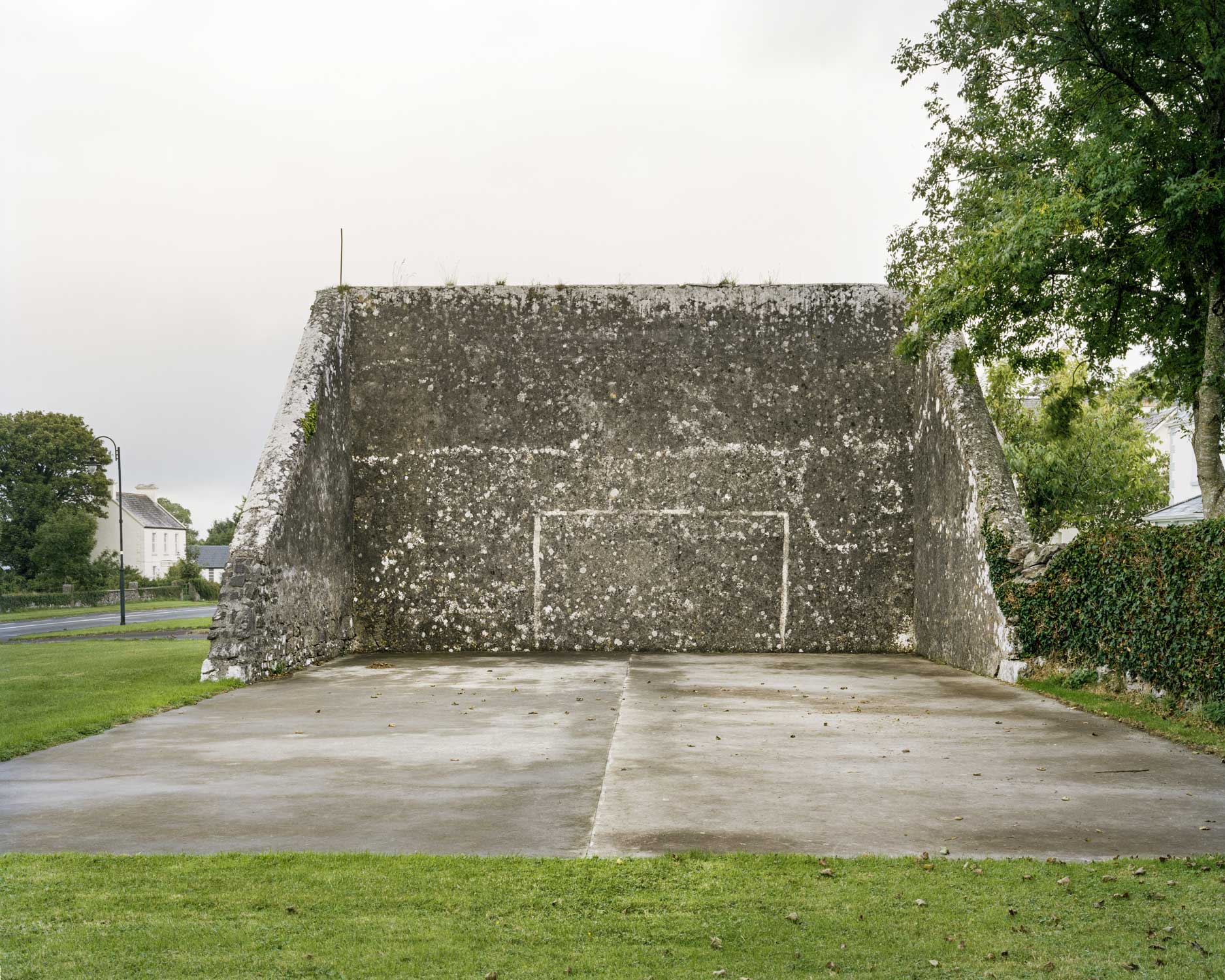
These are relics of a once vibrant chapter of Irish life. Like the dolmens John Montague crafted as a metaphor for the old people of his childhood, the ruins of these abandoned alleys bear silent testimony to a feature of Ireland that has perished through time and modernization. These plain walls were once the thriving open-air theatre's of their day. They were familiar meeting points, where people played games long into long summer evenings, and others gathered for simple companionship and discourse. The alleys came alive at a time in Ireland when human interaction needed little in the way of sophisticated props or accompaniments. In rural Ireland in particular handball captured the public imagination and societies grew around the games and the alleys which staged them. They became prized places of refuge, offering an escape from ordinary, hard-working lives.
At the ball alleys, some strategically placed at crossroads in the open countryside, generations happily fraternized. Some were drawn by the magic and noise of a game which has deep Irish roots. But the alley was more than a sporting venue; it became a vital anchor for the community and an invaluable leisure outlet. It also served as an unofficial meeting point for lovers and revolutionaries. Even as a location for executions. It had an open charter - multiple, indiscriminate possibilities. Like Montague's dolmens, some alleys survive - a portion of them intact and a minority enjoying new leases of life. But the majority are disappearing slowly from the landscape to the point where they will eventually become extinct. Many have been merged and camouflaged into other structures, like farmyard sheds or car parks, so that they are barely recognizable or identifiable. Many others are simply abandoned and overgrown. Old handball players and the game's scattered aficionados will recall their last hurrah 50 odd years ago or more, after they had thrived across the country for over a century, before television and better transport began to signal their decline and offer alternative means of entertainment and social collusion - leaving each one in turn to become a tomb for a lost civilization.
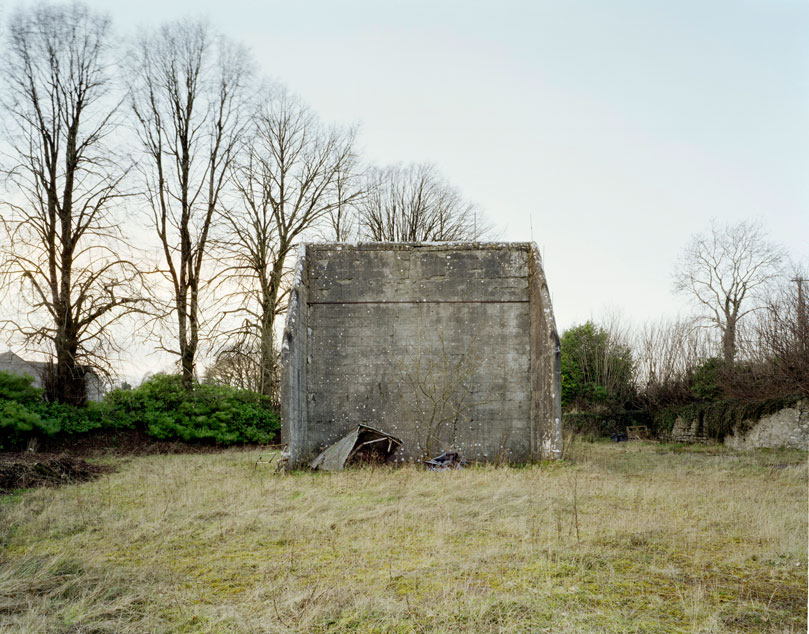
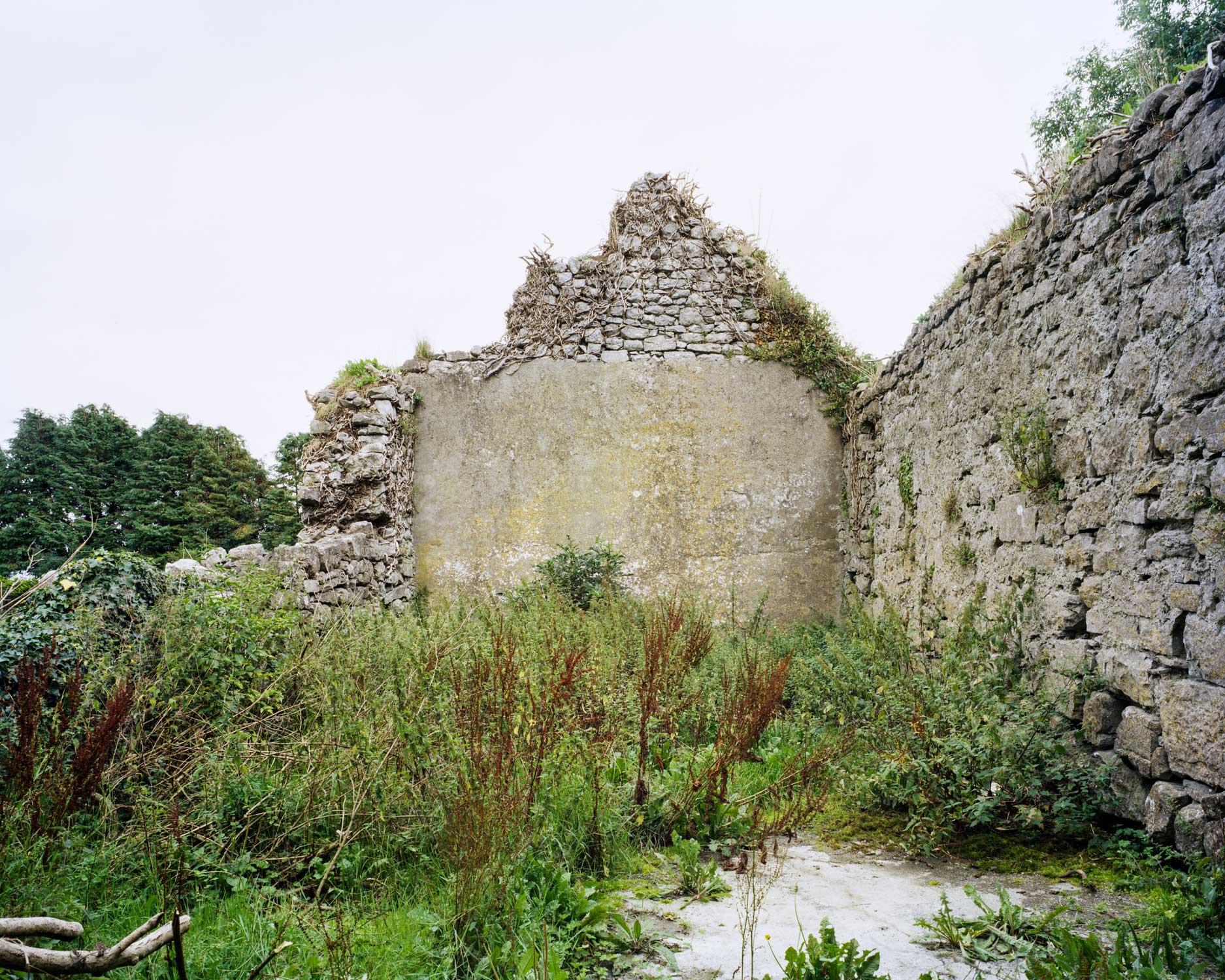
These are relics of a once vibrant chapter of Irish life. Like the dolmens John Montague crafted as a metaphor for the old people of his childhood, the ruins of these abandoned alleys bear silent testimony to a feature of Ireland that has perished through time and modernization. These plain walls were once the thriving open-air theatre's of their day. They were familiar meeting points, where people played games long into long summer evenings, and others gathered for simple companionship and discourse. The alleys came alive at a time in Ireland when human interaction needed little in the way of sophisticated props or accompaniments. In rural Ireland in particular handball captured the public imagination and societies grew around the games and the alleys which staged them. They became prized places of refuge, offering an escape from ordinary, hard-working lives.
At the ball alleys, some strategically placed at crossroads in the open countryside, generations happily fraternized. Some were drawn by the magic and noise of a game which has deep Irish roots. But the alley was more than a sporting venue; it became a vital anchor for the community and an invaluable leisure outlet. It also served as an unofficial meeting point for lovers and revolutionaries. Even as a location for executions. It had an open charter - multiple, indiscriminate possibilities. Like Montague's dolmens, some alleys survive - a portion of them intact and a minority enjoying new leases of life. But the majority are disappearing slowly from the landscape to the point where they will eventually become extinct. Many have been merged and camouflaged into other structures, like farmyard sheds or car parks, so that they are barely recognizable or identifiable. Many others are simply abandoned and overgrown. Old handball players and the game's scattered aficionados will recall their last hurrah 50 odd years ago or more, after they had thrived across the country for over a century, before television and better transport began to signal their decline and offer alternative means of entertainment and social collusion - leaving each one in turn to become a tomb for a lost civilization.
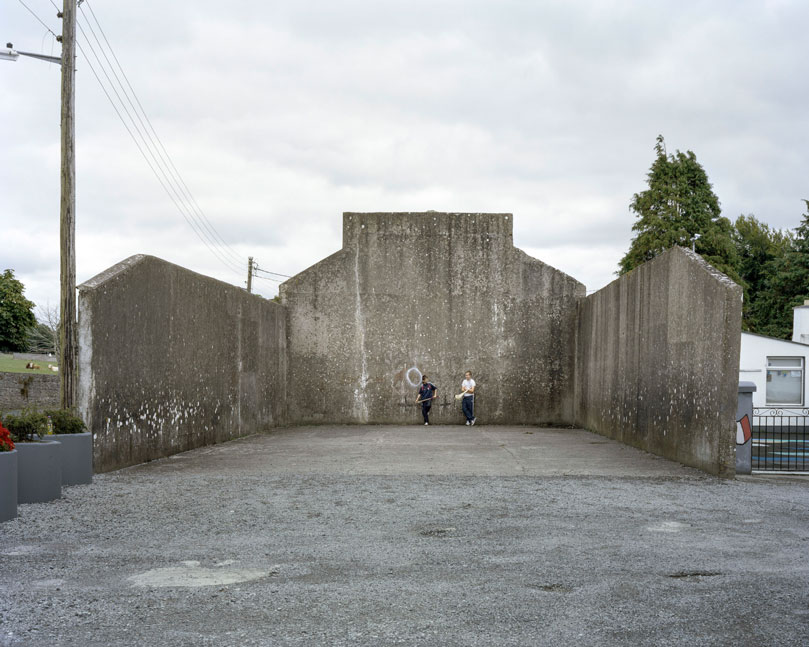
These are relics of a once vibrant chapter of Irish life. Like the dolmens John Montague crafted as a metaphor for the old people of his childhood, the ruins of these abandoned alleys bear silent testimony to a feature of Ireland that has perished through time and modernization. These plain walls were once the thriving open-air theatre's of their day. They were familiar meeting points, where people played games long into long summer evenings, and others gathered for simple companionship and discourse. The alleys came alive at a time in Ireland when human interaction needed little in the way of sophisticated props or accompaniments. In rural Ireland in particular handball captured the public imagination and societies grew around the games and the alleys which staged them. They became prized places of refuge, offering an escape from ordinary, hard-working lives.
At the ball alleys, some strategically placed at crossroads in the open countryside, generations happily fraternized. Some were drawn by the magic and noise of a game which has deep Irish roots. But the alley was more than a sporting venue; it became a vital anchor for the community and an invaluable leisure outlet. It also served as an unofficial meeting point for lovers and revolutionaries. Even as a location for executions. It had an open charter - multiple, indiscriminate possibilities. Like Montague's dolmens, some alleys survive - a portion of them intact and a minority enjoying new leases of life. But the majority are disappearing slowly from the landscape to the point where they will eventually become extinct. Many have been merged and camouflaged into other structures, like farmyard sheds or car parks, so that they are barely recognizable or identifiable. Many others are simply abandoned and overgrown. Old handball players and the game's scattered aficionados will recall their last hurrah 50 odd years ago or more, after they had thrived across the country for over a century, before television and better transport began to signal their decline and offer alternative means of entertainment and social collusion - leaving each one in turn to become a tomb for a lost civilization.
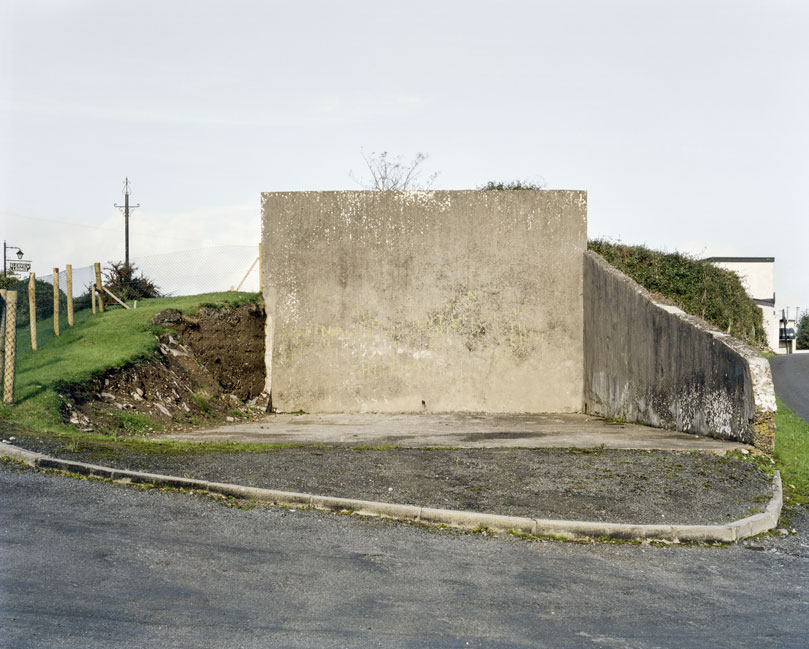
These are relics of a once vibrant chapter of Irish life. Like the dolmens John Montague crafted as a metaphor for the old people of his childhood, the ruins of these abandoned alleys bear silent testimony to a feature of Ireland that has perished through time and modernization. These plain walls were once the thriving open-air theatre's of their day. They were familiar meeting points, where people played games long into long summer evenings, and others gathered for simple companionship and discourse. The alleys came alive at a time in Ireland when human interaction needed little in the way of sophisticated props or accompaniments. In rural Ireland in particular handball captured the public imagination and societies grew around the games and the alleys which staged them. They became prized places of refuge, offering an escape from ordinary, hard-working lives.
At the ball alleys, some strategically placed at crossroads in the open countryside, generations happily fraternized. Some were drawn by the magic and noise of a game which has deep Irish roots. But the alley was more than a sporting venue; it became a vital anchor for the community and an invaluable leisure outlet. It also served as an unofficial meeting point for lovers and revolutionaries. Even as a location for executions. It had an open charter - multiple, indiscriminate possibilities. Like Montague's dolmens, some alleys survive - a portion of them intact and a minority enjoying new leases of life. But the majority are disappearing slowly from the landscape to the point where they will eventually become extinct. Many have been merged and camouflaged into other structures, like farmyard sheds or car parks, so that they are barely recognizable or identifiable. Many others are simply abandoned and overgrown. Old handball players and the game's scattered aficionados will recall their last hurrah 50 odd years ago or more, after they had thrived across the country for over a century, before television and better transport began to signal their decline and offer alternative means of entertainment and social collusion - leaving each one in turn to become a tomb for a lost civilization.
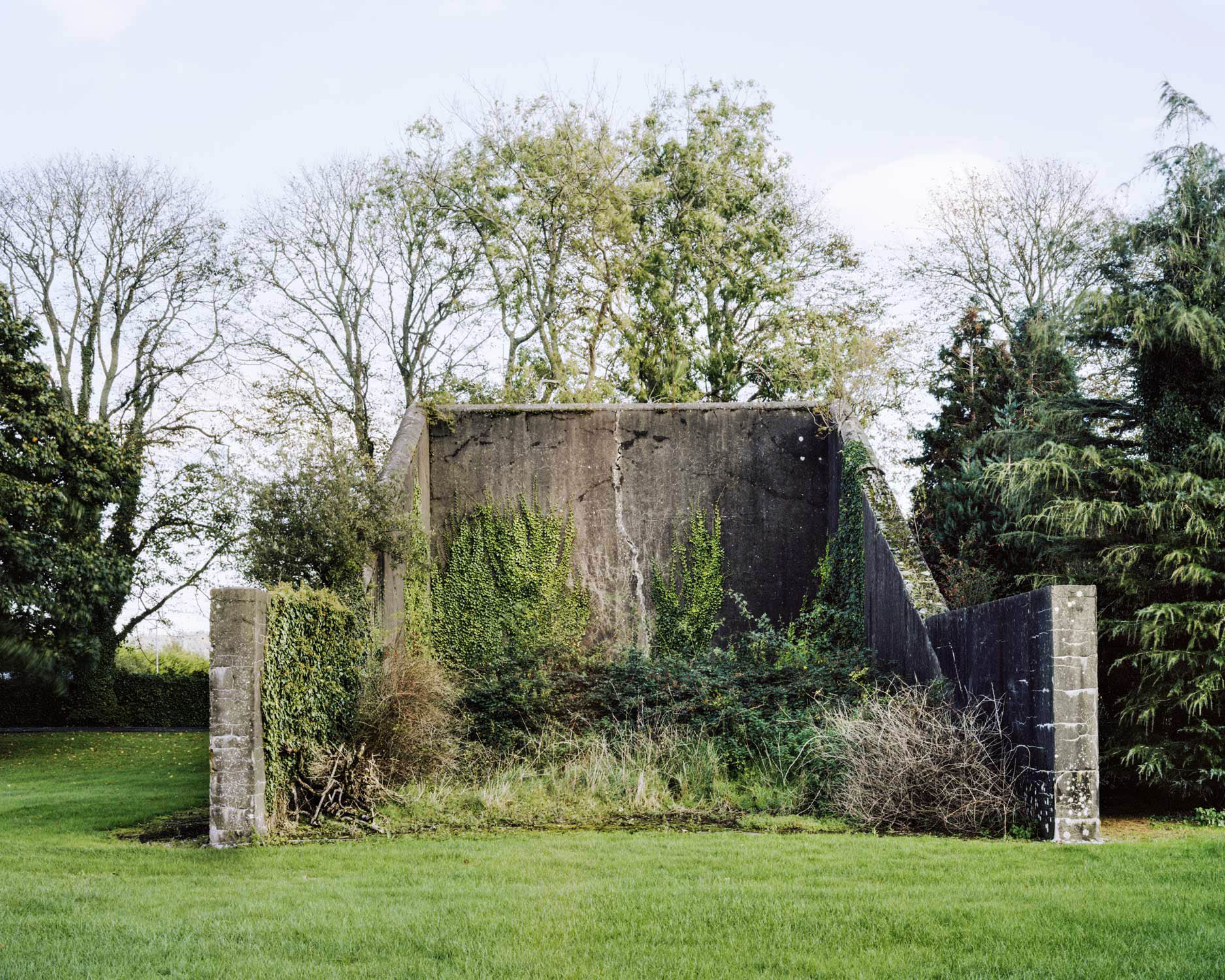
These are relics of a once vibrant chapter of Irish life. Like the dolmens John Montague crafted as a metaphor for the old people of his childhood, the ruins of these abandoned alleys bear silent testimony to a feature of Ireland that has perished through time and modernization. These plain walls were once the thriving open-air theatre's of their day. They were familiar meeting points, where people played games long into long summer evenings, and others gathered for simple companionship and discourse. The alleys came alive at a time in Ireland when human interaction needed little in the way of sophisticated props or accompaniments. In rural Ireland in particular handball captured the public imagination and societies grew around the games and the alleys which staged them. They became prized places of refuge, offering an escape from ordinary, hard-working lives.
At the ball alleys, some strategically placed at crossroads in the open countryside, generations happily fraternized. Some were drawn by the magic and noise of a game which has deep Irish roots. But the alley was more than a sporting venue; it became a vital anchor for the community and an invaluable leisure outlet. It also served as an unofficial meeting point for lovers and revolutionaries. Even as a location for executions. It had an open charter - multiple, indiscriminate possibilities. Like Montague's dolmens, some alleys survive - a portion of them intact and a minority enjoying new leases of life. But the majority are disappearing slowly from the landscape to the point where they will eventually become extinct. Many have been merged and camouflaged into other structures, like farmyard sheds or car parks, so that they are barely recognizable or identifiable. Many others are simply abandoned and overgrown. Old handball players and the game's scattered aficionados will recall their last hurrah 50 odd years ago or more, after they had thrived across the country for over a century, before television and better transport began to signal their decline and offer alternative means of entertainment and social collusion - leaving each one in turn to become a tomb for a lost civilization.

These are relics of a once vibrant chapter of Irish life. Like the dolmens John Montague crafted as a metaphor for the old people of his childhood, the ruins of these abandoned alleys bear silent testimony to a feature of Ireland that has perished through time and modernization. These plain walls were once the thriving open-air theatre's of their day. They were familiar meeting points, where people played games long into long summer evenings, and others gathered for simple companionship and discourse. The alleys came alive at a time in Ireland when human interaction needed little in the way of sophisticated props or accompaniments. In rural Ireland in particular handball captured the public imagination and societies grew around the games and the alleys which staged them. They became prized places of refuge, offering an escape from ordinary, hard-working lives.
At the ball alleys, some strategically placed at crossroads in the open countryside, generations happily fraternized. Some were drawn by the magic and noise of a game which has deep Irish roots. But the alley was more than a sporting venue; it became a vital anchor for the community and an invaluable leisure outlet. It also served as an unofficial meeting point for lovers and revolutionaries. Even as a location for executions. It had an open charter - multiple, indiscriminate possibilities. Like Montague's dolmens, some alleys survive - a portion of them intact and a minority enjoying new leases of life. But the majority are disappearing slowly from the landscape to the point where they will eventually become extinct. Many have been merged and camouflaged into other structures, like farmyard sheds or car parks, so that they are barely recognizable or identifiable. Many others are simply abandoned and overgrown. Old handball players and the game's scattered aficionados will recall their last hurrah 50 odd years ago or more, after they had thrived across the country for over a century, before television and better transport began to signal their decline and offer alternative means of entertainment and social collusion - leaving each one in turn to become a tomb for a lost civilization.
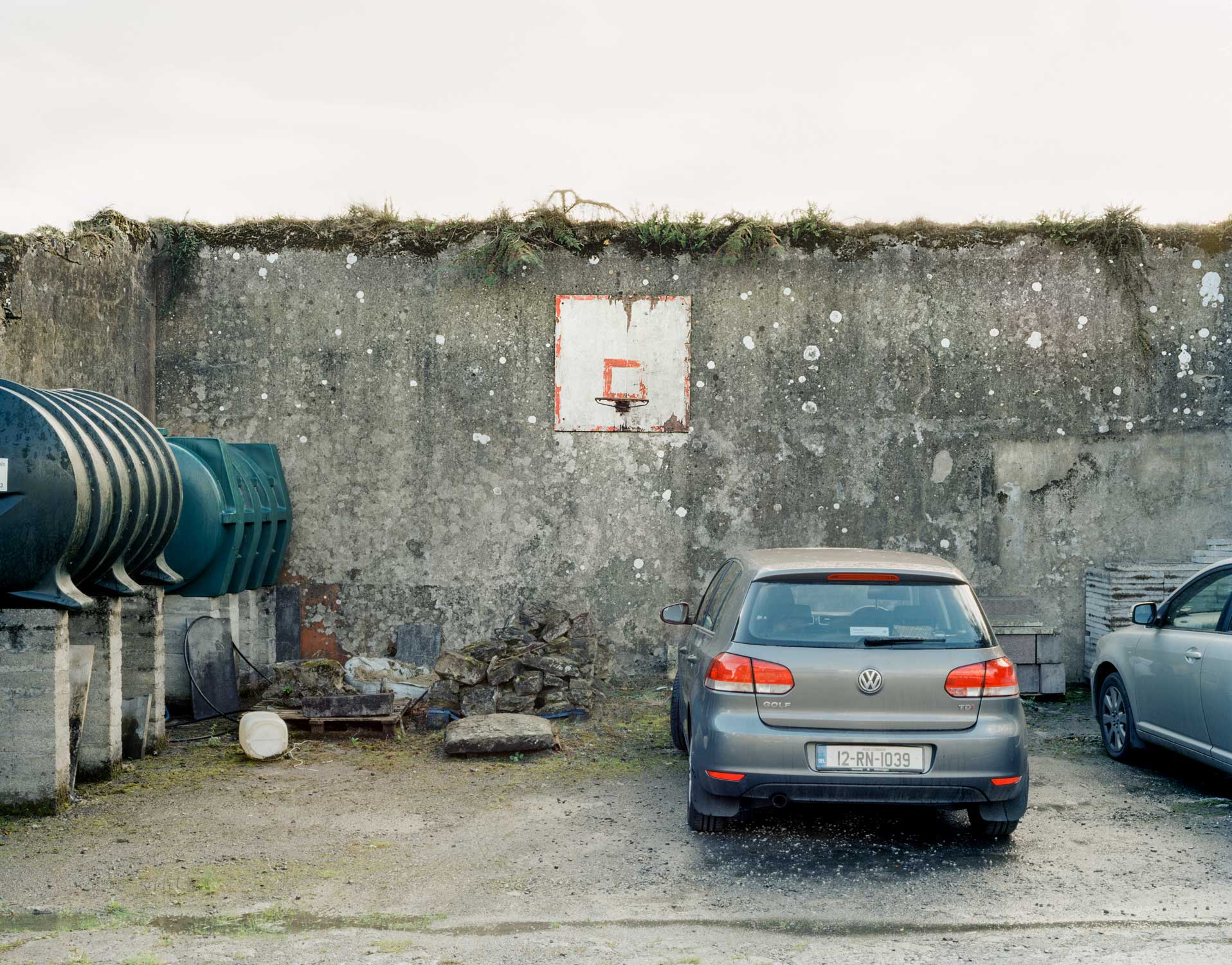
These are relics of a once vibrant chapter of Irish life. Like the dolmens John Montague crafted as a metaphor for the old people of his childhood, the ruins of these abandoned alleys bear silent testimony to a feature of Ireland that has perished through time and modernization. These plain walls were once the thriving open-air theatre's of their day. They were familiar meeting points, where people played games long into long summer evenings, and others gathered for simple companionship and discourse. The alleys came alive at a time in Ireland when human interaction needed little in the way of sophisticated props or accompaniments. In rural Ireland in particular handball captured the public imagination and societies grew around the games and the alleys which staged them. They became prized places of refuge, offering an escape from ordinary, hard-working lives.
At the ball alleys, some strategically placed at crossroads in the open countryside, generations happily fraternized. Some were drawn by the magic and noise of a game which has deep Irish roots. But the alley was more than a sporting venue; it became a vital anchor for the community and an invaluable leisure outlet. It also served as an unofficial meeting point for lovers and revolutionaries. Even as a location for executions. It had an open charter - multiple, indiscriminate possibilities. Like Montague's dolmens, some alleys survive - a portion of them intact and a minority enjoying new leases of life. But the majority are disappearing slowly from the landscape to the point where they will eventually become extinct. Many have been merged and camouflaged into other structures, like farmyard sheds or car parks, so that they are barely recognizable or identifiable. Many others are simply abandoned and overgrown. Old handball players and the game's scattered aficionados will recall their last hurrah 50 odd years ago or more, after they had thrived across the country for over a century, before television and better transport began to signal their decline and offer alternative means of entertainment and social collusion - leaving each one in turn to become a tomb for a lost civilization.
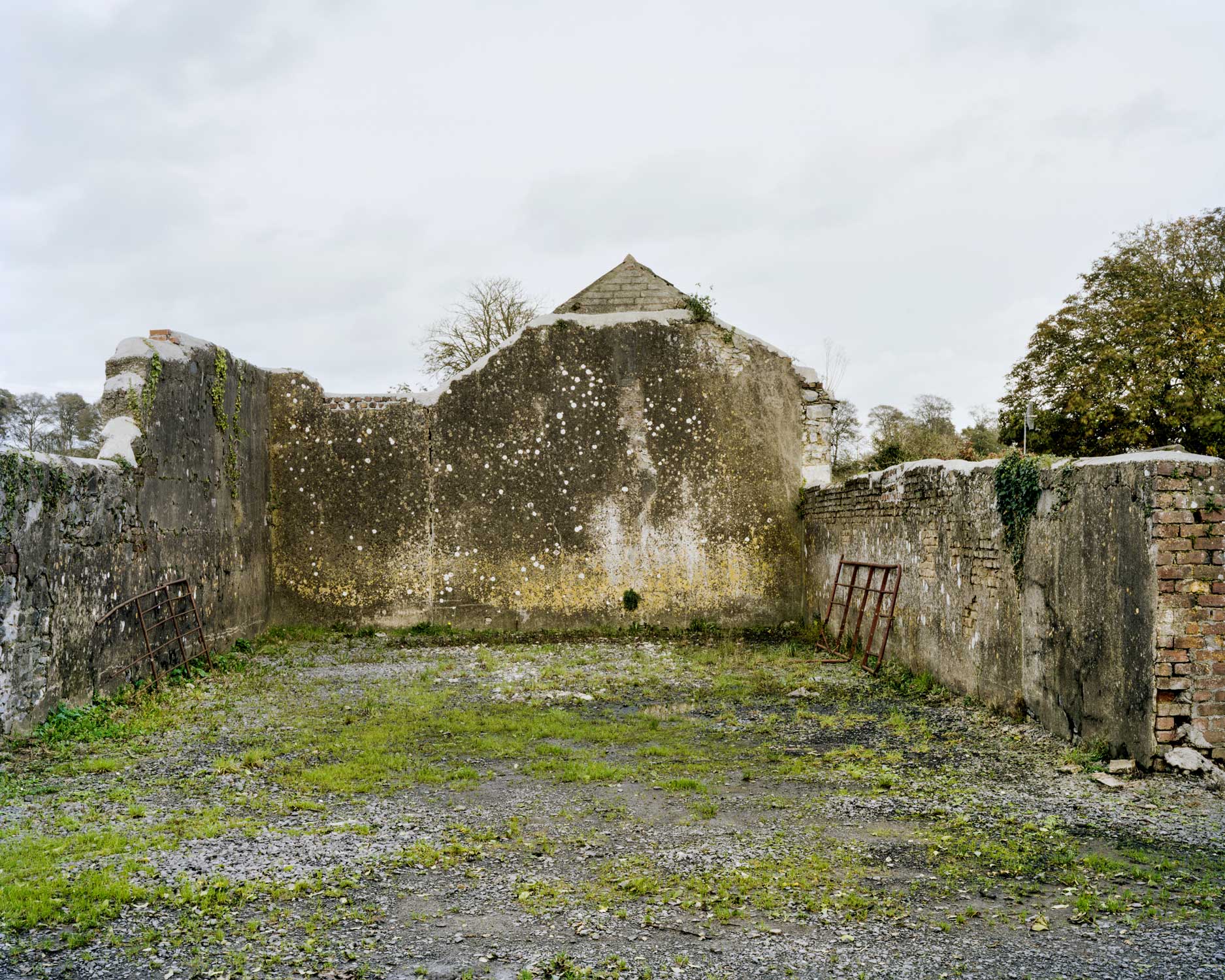
These are relics of a once vibrant chapter of Irish life. Like the dolmens John Montague crafted as a metaphor for the old people of his childhood, the ruins of these abandoned alleys bear silent testimony to a feature of Ireland that has perished through time and modernization. These plain walls were once the thriving open-air theatre's of their day. They were familiar meeting points, where people played games long into long summer evenings, and others gathered for simple companionship and discourse. The alleys came alive at a time in Ireland when human interaction needed little in the way of sophisticated props or accompaniments. In rural Ireland in particular handball captured the public imagination and societies grew around the games and the alleys which staged them. They became prized places of refuge, offering an escape from ordinary, hard-working lives.
At the ball alleys, some strategically placed at crossroads in the open countryside, generations happily fraternized. Some were drawn by the magic and noise of a game which has deep Irish roots. But the alley was more than a sporting venue; it became a vital anchor for the community and an invaluable leisure outlet. It also served as an unofficial meeting point for lovers and revolutionaries. Even as a location for executions. It had an open charter - multiple, indiscriminate possibilities. Like Montague's dolmens, some alleys survive - a portion of them intact and a minority enjoying new leases of life. But the majority are disappearing slowly from the landscape to the point where they will eventually become extinct. Many have been merged and camouflaged into other structures, like farmyard sheds or car parks, so that they are barely recognizable or identifiable. Many others are simply abandoned and overgrown. Old handball players and the game's scattered aficionados will recall their last hurrah 50 odd years ago or more, after they had thrived across the country for over a century, before television and better transport began to signal their decline and offer alternative means of entertainment and social collusion - leaving each one in turn to become a tomb for a lost civilization.
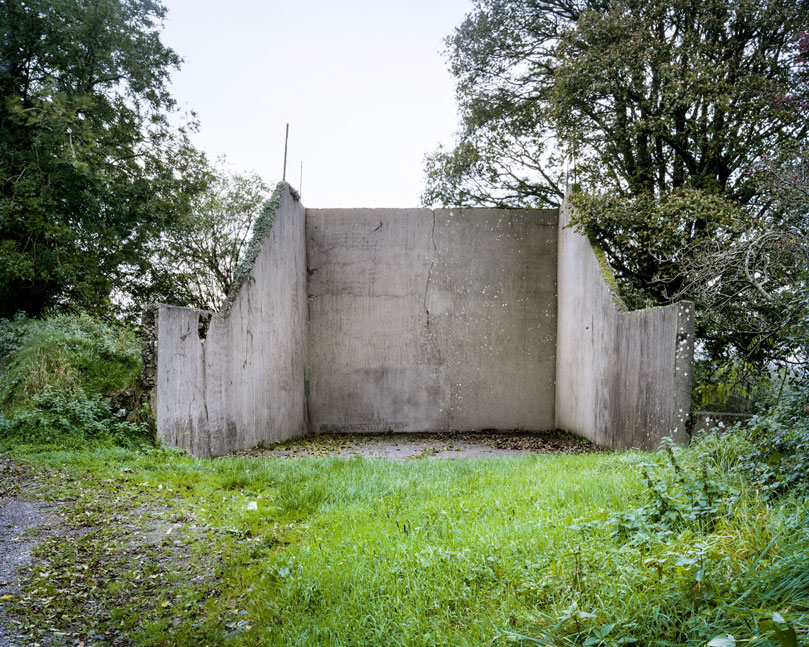
These are relics of a once vibrant chapter of Irish life. Like the dolmens John Montague crafted as a metaphor for the old people of his childhood, the ruins of these abandoned alleys bear silent testimony to a feature of Ireland that has perished through time and modernization. These plain walls were once the thriving open-air theatre's of their day. They were familiar meeting points, where people played games long into long summer evenings, and others gathered for simple companionship and discourse. The alleys came alive at a time in Ireland when human interaction needed little in the way of sophisticated props or accompaniments. In rural Ireland in particular handball captured the public imagination and societies grew around the games and the alleys which staged them. They became prized places of refuge, offering an escape from ordinary, hard-working lives.
At the ball alleys, some strategically placed at crossroads in the open countryside, generations happily fraternized. Some were drawn by the magic and noise of a game which has deep Irish roots. But the alley was more than a sporting venue; it became a vital anchor for the community and an invaluable leisure outlet. It also served as an unofficial meeting point for lovers and revolutionaries. Even as a location for executions. It had an open charter - multiple, indiscriminate possibilities. Like Montague's dolmens, some alleys survive - a portion of them intact and a minority enjoying new leases of life. But the majority are disappearing slowly from the landscape to the point where they will eventually become extinct. Many have been merged and camouflaged into other structures, like farmyard sheds or car parks, so that they are barely recognizable or identifiable. Many others are simply abandoned and overgrown. Old handball players and the game's scattered aficionados will recall their last hurrah 50 odd years ago or more, after they had thrived across the country for over a century, before television and better transport began to signal their decline and offer alternative means of entertainment and social collusion - leaving each one in turn to become a tomb for a lost civilization.
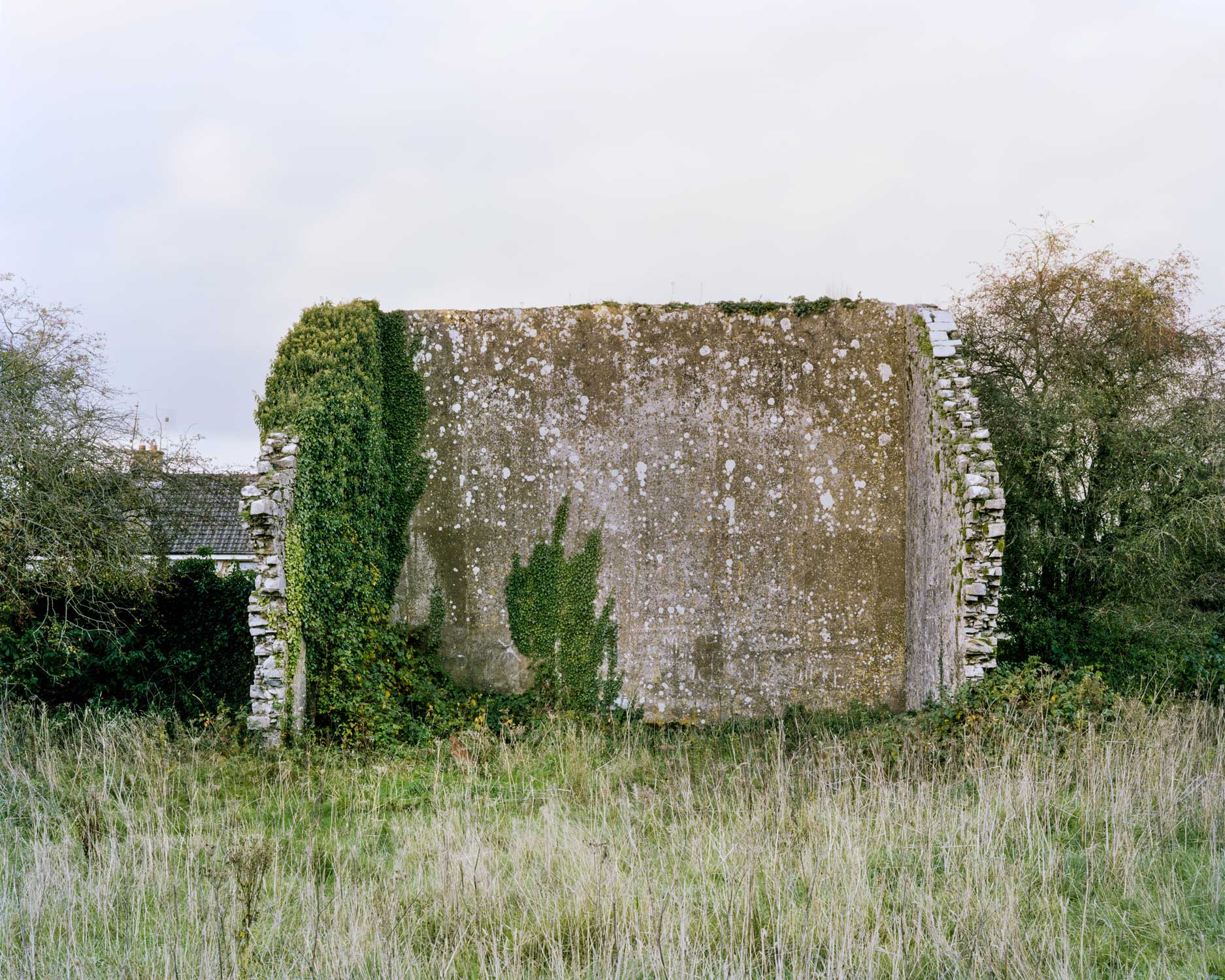
These are relics of a once vibrant chapter of Irish life. Like the dolmens John Montague crafted as a metaphor for the old people of his childhood, the ruins of these abandoned alleys bear silent testimony to a feature of Ireland that has perished through time and modernization. These plain walls were once the thriving open-air theatre's of their day. They were familiar meeting points, where people played games long into long summer evenings, and others gathered for simple companionship and discourse. The alleys came alive at a time in Ireland when human interaction needed little in the way of sophisticated props or accompaniments. In rural Ireland in particular handball captured the public imagination and societies grew around the games and the alleys which staged them. They became prized places of refuge, offering an escape from ordinary, hard-working lives.
At the ball alleys, some strategically placed at crossroads in the open countryside, generations happily fraternized. Some were drawn by the magic and noise of a game which has deep Irish roots. But the alley was more than a sporting venue; it became a vital anchor for the community and an invaluable leisure outlet. It also served as an unofficial meeting point for lovers and revolutionaries. Even as a location for executions. It had an open charter - multiple, indiscriminate possibilities. Like Montague's dolmens, some alleys survive - a portion of them intact and a minority enjoying new leases of life. But the majority are disappearing slowly from the landscape to the point where they will eventually become extinct. Many have been merged and camouflaged into other structures, like farmyard sheds or car parks, so that they are barely recognizable or identifiable. Many others are simply abandoned and overgrown. Old handball players and the game's scattered aficionados will recall their last hurrah 50 odd years ago or more, after they had thrived across the country for over a century, before television and better transport began to signal their decline and offer alternative means of entertainment and social collusion - leaving each one in turn to become a tomb for a lost civilization.
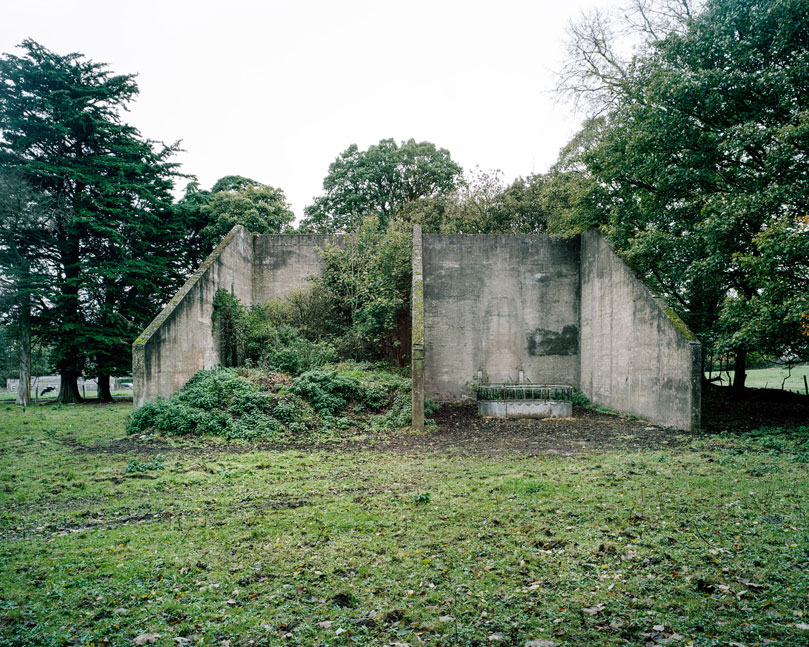
These are relics of a once vibrant chapter of Irish life. Like the dolmens John Montague crafted as a metaphor for the old people of his childhood, the ruins of these abandoned alleys bear silent testimony to a feature of Ireland that has perished through time and modernization. These plain walls were once the thriving open-air theatre's of their day. They were familiar meeting points, where people played games long into long summer evenings, and others gathered for simple companionship and discourse. The alleys came alive at a time in Ireland when human interaction needed little in the way of sophisticated props or accompaniments. In rural Ireland in particular handball captured the public imagination and societies grew around the games and the alleys which staged them. They became prized places of refuge, offering an escape from ordinary, hard-working lives.
At the ball alleys, some strategically placed at crossroads in the open countryside, generations happily fraternized. Some were drawn by the magic and noise of a game which has deep Irish roots. But the alley was more than a sporting venue; it became a vital anchor for the community and an invaluable leisure outlet. It also served as an unofficial meeting point for lovers and revolutionaries. Even as a location for executions. It had an open charter - multiple, indiscriminate possibilities. Like Montague's dolmens, some alleys survive - a portion of them intact and a minority enjoying new leases of life. But the majority are disappearing slowly from the landscape to the point where they will eventually become extinct. Many have been merged and camouflaged into other structures, like farmyard sheds or car parks, so that they are barely recognizable or identifiable. Many others are simply abandoned and overgrown. Old handball players and the game's scattered aficionados will recall their last hurrah 50 odd years ago or more, after they had thrived across the country for over a century, before television and better transport began to signal their decline and offer alternative means of entertainment and social collusion - leaving each one in turn to become a tomb for a lost civilization.

These are relics of a once vibrant chapter of Irish life. Like the dolmens John Montague crafted as a metaphor for the old people of his childhood, the ruins of these abandoned alleys bear silent testimony to a feature of Ireland that has perished through time and modernization. These plain walls were once the thriving open-air theatre's of their day. They were familiar meeting points, where people played games long into long summer evenings, and others gathered for simple companionship and discourse. The alleys came alive at a time in Ireland when human interaction needed little in the way of sophisticated props or accompaniments. In rural Ireland in particular handball captured the public imagination and societies grew around the games and the alleys which staged them. They became prized places of refuge, offering an escape from ordinary, hard-working lives.
At the ball alleys, some strategically placed at crossroads in the open countryside, generations happily fraternized. Some were drawn by the magic and noise of a game which has deep Irish roots. But the alley was more than a sporting venue; it became a vital anchor for the community and an invaluable leisure outlet. It also served as an unofficial meeting point for lovers and revolutionaries. Even as a location for executions. It had an open charter - multiple, indiscriminate possibilities. Like Montague's dolmens, some alleys survive - a portion of them intact and a minority enjoying new leases of life. But the majority are disappearing slowly from the landscape to the point where they will eventually become extinct. Many have been merged and camouflaged into other structures, like farmyard sheds or car parks, so that they are barely recognizable or identifiable. Many others are simply abandoned and overgrown. Old handball players and the game's scattered aficionados will recall their last hurrah 50 odd years ago or more, after they had thrived across the country for over a century, before television and better transport began to signal their decline and offer alternative means of entertainment and social collusion - leaving each one in turn to become a tomb for a lost civilization.
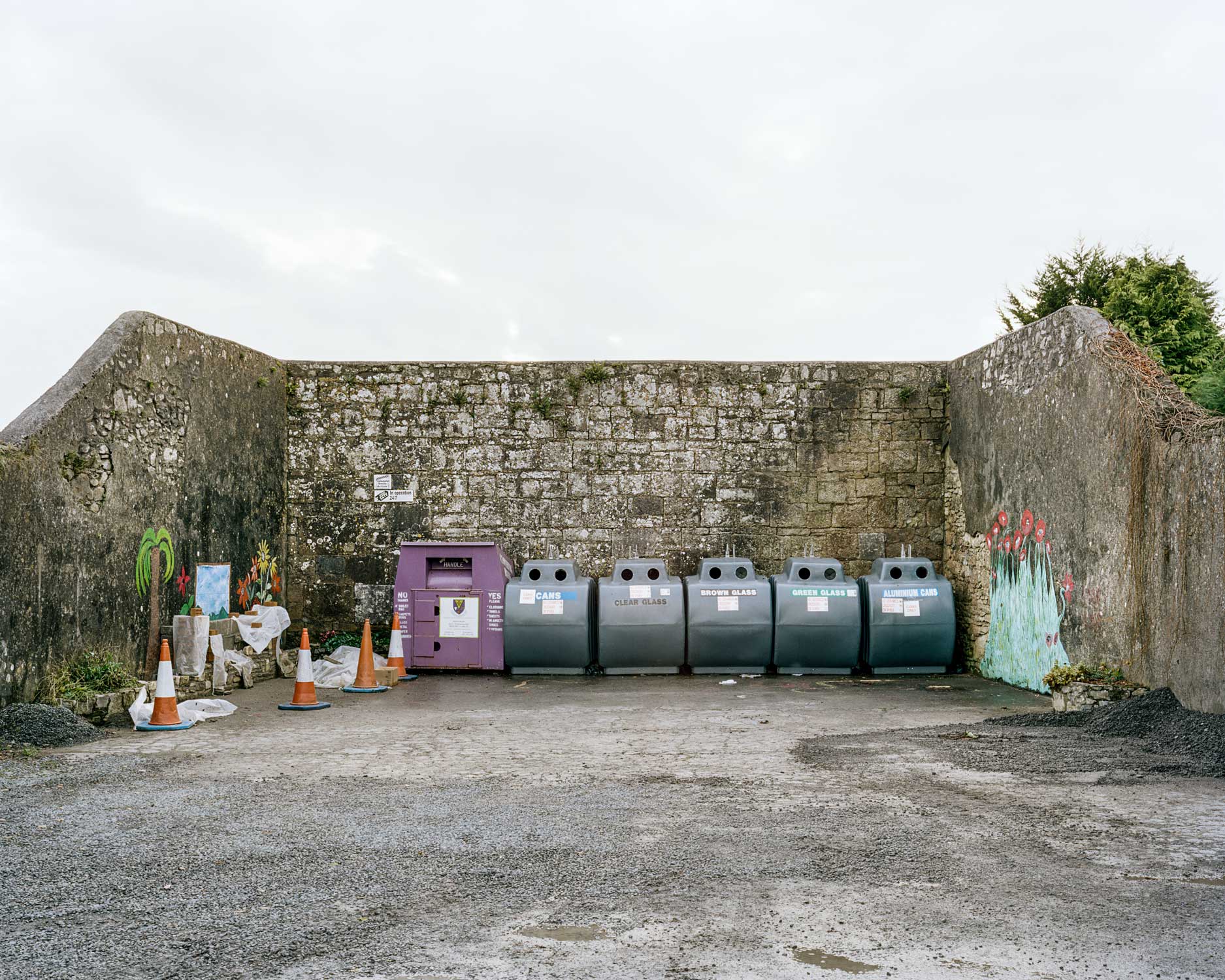
These are relics of a once vibrant chapter of Irish life. Like the dolmens John Montague crafted as a metaphor for the old people of his childhood, the ruins of these abandoned alleys bear silent testimony to a feature of Ireland that has perished through time and modernization. These plain walls were once the thriving open-air theatre's of their day. They were familiar meeting points, where people played games long into long summer evenings, and others gathered for simple companionship and discourse. The alleys came alive at a time in Ireland when human interaction needed little in the way of sophisticated props or accompaniments. In rural Ireland in particular handball captured the public imagination and societies grew around the games and the alleys which staged them. They became prized places of refuge, offering an escape from ordinary, hard-working lives.
At the ball alleys, some strategically placed at crossroads in the open countryside, generations happily fraternized. Some were drawn by the magic and noise of a game which has deep Irish roots. But the alley was more than a sporting venue; it became a vital anchor for the community and an invaluable leisure outlet. It also served as an unofficial meeting point for lovers and revolutionaries. Even as a location for executions. It had an open charter - multiple, indiscriminate possibilities. Like Montague's dolmens, some alleys survive - a portion of them intact and a minority enjoying new leases of life. But the majority are disappearing slowly from the landscape to the point where they will eventually become extinct. Many have been merged and camouflaged into other structures, like farmyard sheds or car parks, so that they are barely recognizable or identifiable. Many others are simply abandoned and overgrown. Old handball players and the game's scattered aficionados will recall their last hurrah 50 odd years ago or more, after they had thrived across the country for over a century, before television and better transport began to signal their decline and offer alternative means of entertainment and social collusion - leaving each one in turn to become a tomb for a lost civilization.
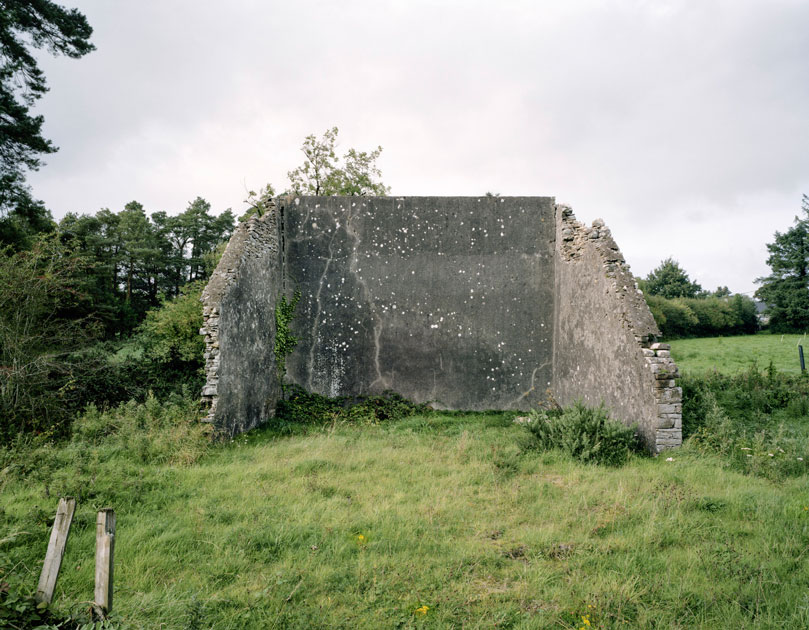
These are relics of a once vibrant chapter of Irish life. Like the dolmens John Montague crafted as a metaphor for the old people of his childhood, the ruins of these abandoned alleys bear silent testimony to a feature of Ireland that has perished through time and modernization. These plain walls were once the thriving open-air theatre's of their day. They were familiar meeting points, where people played games long into long summer evenings, and others gathered for simple companionship and discourse. The alleys came alive at a time in Ireland when human interaction needed little in the way of sophisticated props or accompaniments. In rural Ireland in particular handball captured the public imagination and societies grew around the games and the alleys which staged them. They became prized places of refuge, offering an escape from ordinary, hard-working lives.
At the ball alleys, some strategically placed at crossroads in the open countryside, generations happily fraternized. Some were drawn by the magic and noise of a game which has deep Irish roots. But the alley was more than a sporting venue; it became a vital anchor for the community and an invaluable leisure outlet. It also served as an unofficial meeting point for lovers and revolutionaries. Even as a location for executions. It had an open charter - multiple, indiscriminate possibilities. Like Montague's dolmens, some alleys survive - a portion of them intact and a minority enjoying new leases of life. But the majority are disappearing slowly from the landscape to the point where they will eventually become extinct. Many have been merged and camouflaged into other structures, like farmyard sheds or car parks, so that they are barely recognizable or identifiable. Many others are simply abandoned and overgrown. Old handball players and the game's scattered aficionados will recall their last hurrah 50 odd years ago or more, after they had thrived across the country for over a century, before television and better transport began to signal their decline and offer alternative means of entertainment and social collusion - leaving each one in turn to become a tomb for a lost civilization.
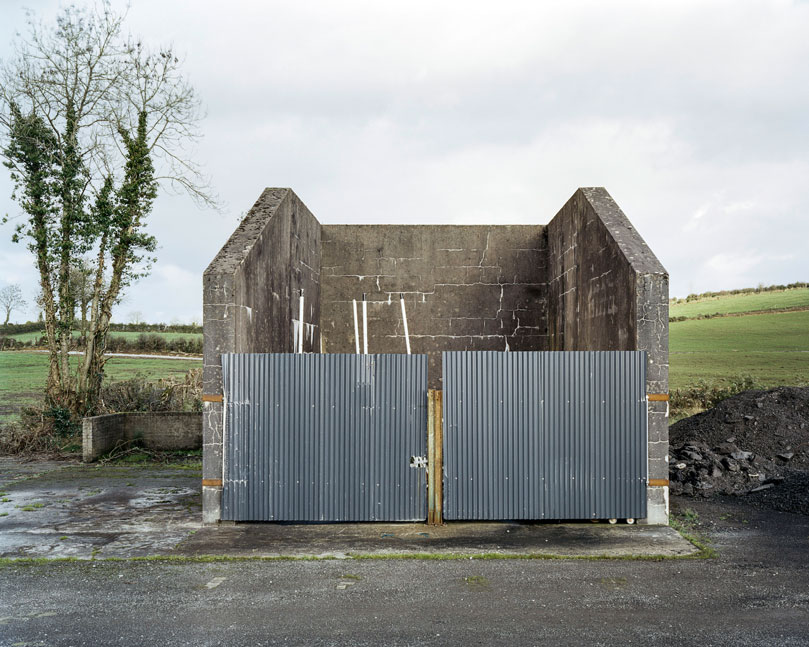
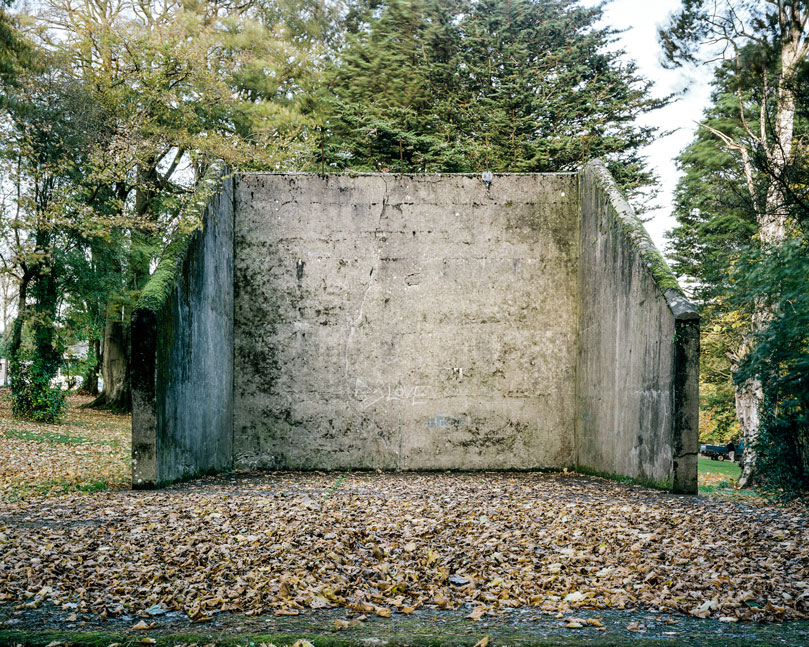
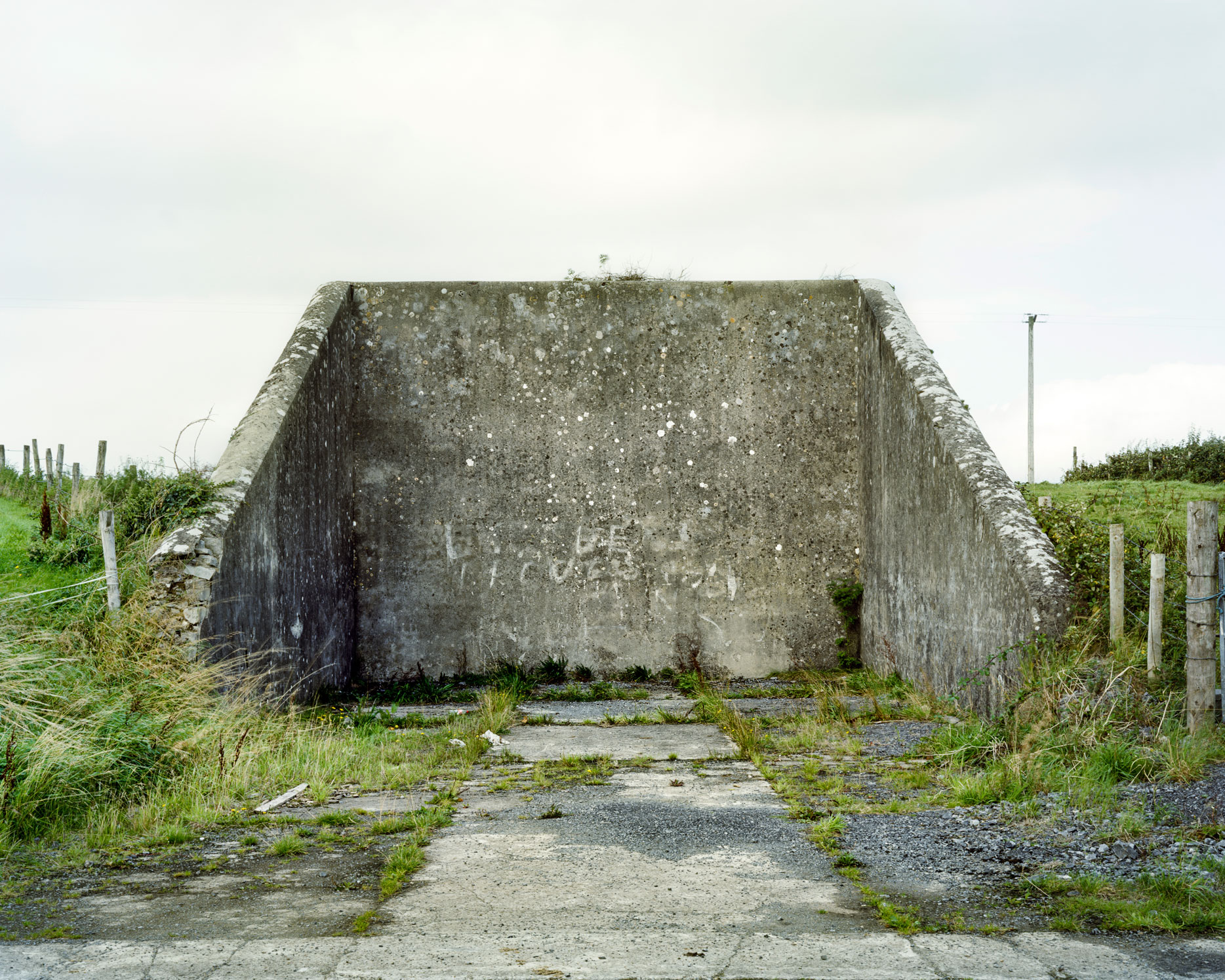
These are relics of a once vibrant chapter of Irish life. Like the dolmens John Montague crafted as a metaphor for the old people of his childhood, the ruins of these abandoned alleys bear silent testimony to a feature of Ireland that has perished through time and modernization. These plain walls were once the thriving open-air theatre's of their day. They were familiar meeting points, where people played games long into long summer evenings, and others gathered for simple companionship and discourse. The alleys came alive at a time in Ireland when human interaction needed little in the way of sophisticated props or accompaniments. In rural Ireland in particular handball captured the public imagination and societies grew around the games and the alleys which staged them. They became prized places of refuge, offering an escape from ordinary, hard-working lives.
At the ball alleys, some strategically placed at crossroads in the open countryside, generations happily fraternized. Some were drawn by the magic and noise of a game which has deep Irish roots. But the alley was more than a sporting venue; it became a vital anchor for the community and an invaluable leisure outlet. It also served as an unofficial meeting point for lovers and revolutionaries. Even as a location for executions. It had an open charter - multiple, indiscriminate possibilities. Like Montague's dolmens, some alleys survive - a portion of them intact and a minority enjoying new leases of life. But the majority are disappearing slowly from the landscape to the point where they will eventually become extinct. Many have been merged and camouflaged into other structures, like farmyard sheds or car parks, so that they are barely recognizable or identifiable. Many others are simply abandoned and overgrown. Old handball players and the game's scattered aficionados will recall their last hurrah 50 odd years ago or more, after they had thrived across the country for over a century, before television and better transport began to signal their decline and offer alternative means of entertainment and social collusion - leaving each one in turn to become a tomb for a lost civilization.
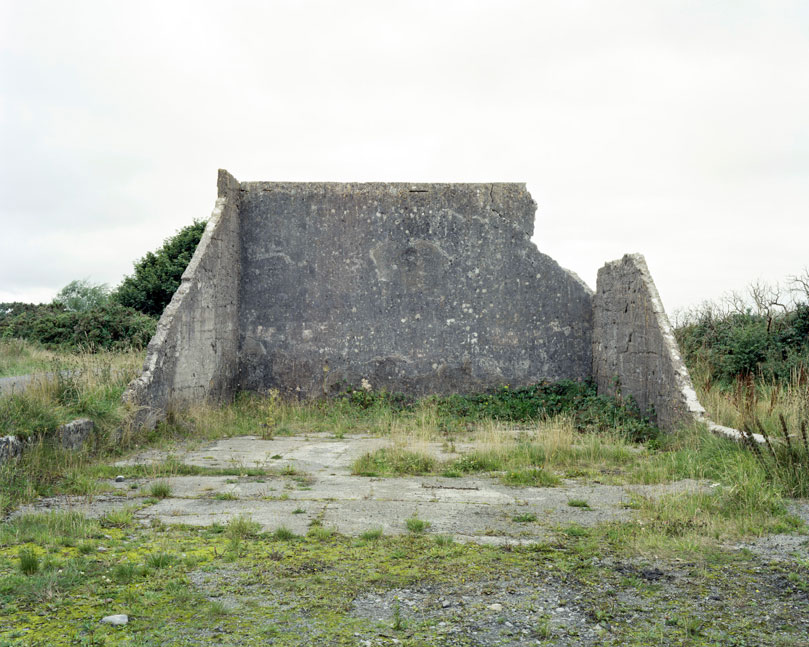
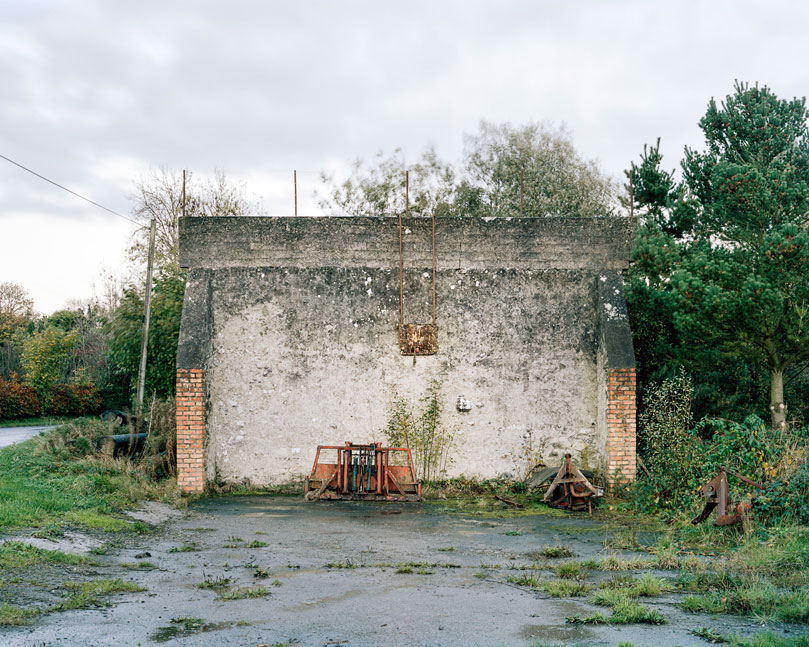
These are relics of a once vibrant chapter of Irish life. Like the dolmens John Montague crafted as a metaphor for the old people of his childhood, the ruins of these abandoned alleys bear silent testimony to a feature of Ireland that has perished through time and modernization. These plain walls were once the thriving open-air theatre's of their day. They were familiar meeting points, where people played games long into long summer evenings, and others gathered for simple companionship and discourse. The alleys came alive at a time in Ireland when human interaction needed little in the way of sophisticated props or accompaniments. In rural Ireland in particular handball captured the public imagination and societies grew around the games and the alleys which staged them. They became prized places of refuge, offering an escape from ordinary, hard-working lives.
At the ball alleys, some strategically placed at crossroads in the open countryside, generations happily fraternized. Some were drawn by the magic and noise of a game which has deep Irish roots. But the alley was more than a sporting venue; it became a vital anchor for the community and an invaluable leisure outlet. It also served as an unofficial meeting point for lovers and revolutionaries. Even as a location for executions. It had an open charter - multiple, indiscriminate possibilities. Like Montague's dolmens, some alleys survive - a portion of them intact and a minority enjoying new leases of life. But the majority are disappearing slowly from the landscape to the point where they will eventually become extinct. Many have been merged and camouflaged into other structures, like farmyard sheds or car parks, so that they are barely recognizable or identifiable. Many others are simply abandoned and overgrown. Old handball players and the game's scattered aficionados will recall their last hurrah 50 odd years ago or more, after they had thrived across the country for over a century, before television and better transport began to signal their decline and offer alternative means of entertainment and social collusion - leaving each one in turn to become a tomb for a lost civilization.

These are relics of a once vibrant chapter of Irish life. Like the dolmens John Montague crafted as a metaphor for the old people of his childhood, the ruins of these abandoned alleys bear silent testimony to a feature of Ireland that has perished through time and modernization. These plain walls were once the thriving open-air theatre's of their day. They were familiar meeting points, where people played games long into long summer evenings, and others gathered for simple companionship and discourse. The alleys came alive at a time in Ireland when human interaction needed little in the way of sophisticated props or accompaniments. In rural Ireland in particular handball captured the public imagination and societies grew around the games and the alleys which staged them. They became prized places of refuge, offering an escape from ordinary, hard-working lives.
At the ball alleys, some strategically placed at crossroads in the open countryside, generations happily fraternized. Some were drawn by the magic and noise of a game which has deep Irish roots. But the alley was more than a sporting venue; it became a vital anchor for the community and an invaluable leisure outlet. It also served as an unofficial meeting point for lovers and revolutionaries. Even as a location for executions. It had an open charter - multiple, indiscriminate possibilities. Like Montague's dolmens, some alleys survive - a portion of them intact and a minority enjoying new leases of life. But the majority are disappearing slowly from the landscape to the point where they will eventually become extinct. Many have been merged and camouflaged into other structures, like farmyard sheds or car parks, so that they are barely recognizable or identifiable. Many others are simply abandoned and overgrown. Old handball players and the game's scattered aficionados will recall their last hurrah 50 odd years ago or more, after they had thrived across the country for over a century, before television and better transport began to signal their decline and offer alternative means of entertainment and social collusion - leaving each one in turn to become a tomb for a lost civilization.
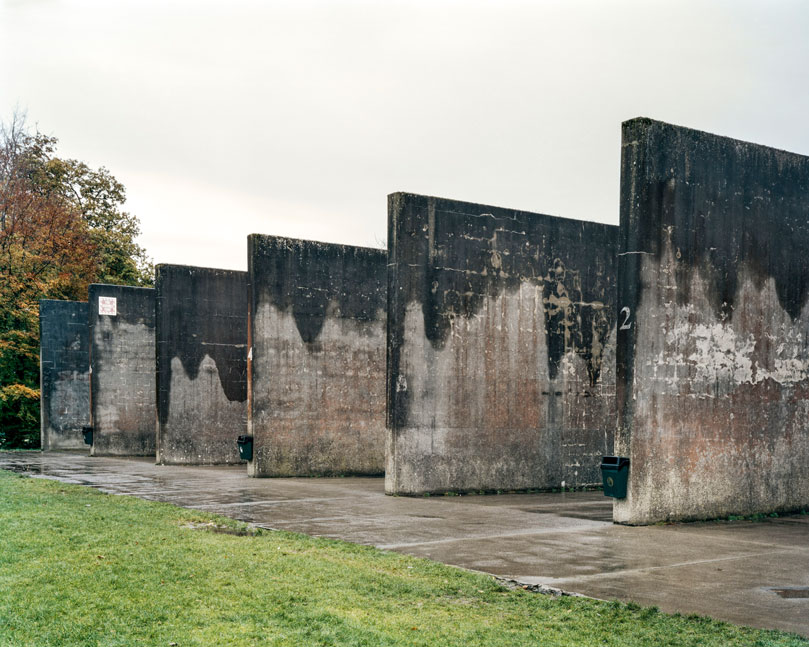
These are relics of a once vibrant chapter of Irish life. Like the dolmens John Montague crafted as a metaphor for the old people of his childhood, the ruins of these abandoned alleys bear silent testimony to a feature of Ireland that has perished through time and modernization. These plain walls were once the thriving open-air theatre's of their day. They were familiar meeting points, where people played games long into long summer evenings, and others gathered for simple companionship and discourse. The alleys came alive at a time in Ireland when human interaction needed little in the way of sophisticated props or accompaniments. In rural Ireland in particular handball captured the public imagination and societies grew around the games and the alleys which staged them. They became prized places of refuge, offering an escape from ordinary, hard-working lives.
At the ball alleys, some strategically placed at crossroads in the open countryside, generations happily fraternized. Some were drawn by the magic and noise of a game which has deep Irish roots. But the alley was more than a sporting venue; it became a vital anchor for the community and an invaluable leisure outlet. It also served as an unofficial meeting point for lovers and revolutionaries. Even as a location for executions. It had an open charter - multiple, indiscriminate possibilities. Like Montague's dolmens, some alleys survive - a portion of them intact and a minority enjoying new leases of life. But the majority are disappearing slowly from the landscape to the point where they will eventually become extinct. Many have been merged and camouflaged into other structures, like farmyard sheds or car parks, so that they are barely recognizable or identifiable. Many others are simply abandoned and overgrown. Old handball players and the game's scattered aficionados will recall their last hurrah 50 odd years ago or more, after they had thrived across the country for over a century, before television and better transport began to signal their decline and offer alternative means of entertainment and social collusion - leaving each one in turn to become a tomb for a lost civilization.
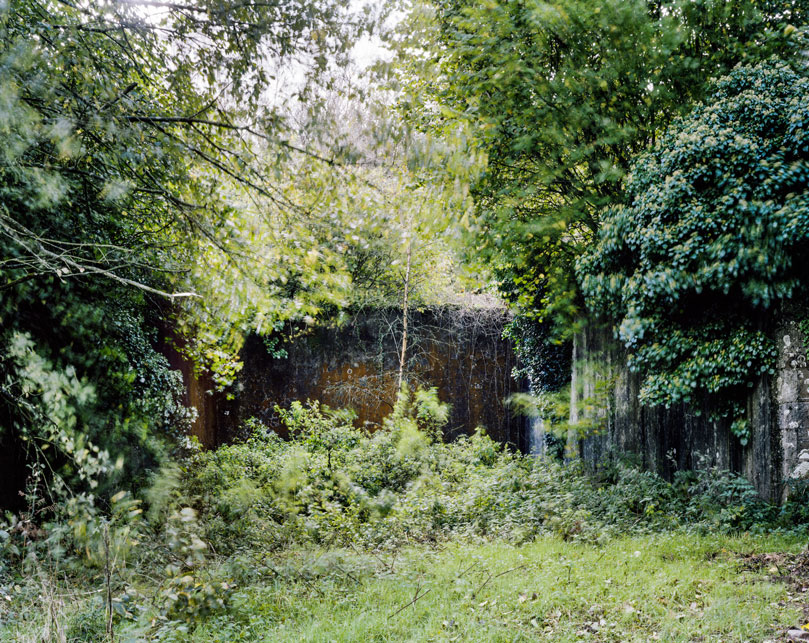
These are relics of a once vibrant chapter of Irish life. Like the dolmens John Montague crafted as a metaphor for the old people of his childhood, the ruins of these abandoned alleys bear silent testimony to a feature of Ireland that has perished through time and modernization. These plain walls were once the thriving open-air theatre's of their day. They were familiar meeting points, where people played games long into long summer evenings, and others gathered for simple companionship and discourse. The alleys came alive at a time in Ireland when human interaction needed little in the way of sophisticated props or accompaniments. In rural Ireland in particular handball captured the public imagination and societies grew around the games and the alleys which staged them. They became prized places of refuge, offering an escape from ordinary, hard-working lives.
At the ball alleys, some strategically placed at crossroads in the open countryside, generations happily fraternized. Some were drawn by the magic and noise of a game which has deep Irish roots. But the alley was more than a sporting venue; it became a vital anchor for the community and an invaluable leisure outlet. It also served as an unofficial meeting point for lovers and revolutionaries. Even as a location for executions. It had an open charter - multiple, indiscriminate possibilities. Like Montague's dolmens, some alleys survive - a portion of them intact and a minority enjoying new leases of life. But the majority are disappearing slowly from the landscape to the point where they will eventually become extinct. Many have been merged and camouflaged into other structures, like farmyard sheds or car parks, so that they are barely recognizable or identifiable. Many others are simply abandoned and overgrown. Old handball players and the game's scattered aficionados will recall their last hurrah 50 odd years ago or more, after they had thrived across the country for over a century, before television and better transport began to signal their decline and offer alternative means of entertainment and social collusion - leaving each one in turn to become a tomb for a lost civilization.
The Handball Alley










































